(Epi)genetics of Human Reproduction
Department of Medical Biology and Genetics
Research group: (Epi)genetics of Human Reproduction
Prof. Saša Ostojić, MD, PhD
Group members: Assoc. Prof. Nina Pereza, MD, PhD, Asst. Prof. Sanja Dević Pavlić, M.Sc., PhD, Anita Barišić, MD, PhD, Teaching Assistant Tea Mladenić, M.Sc., Prof. Borut Peterlin, MD, PhD, Prof. Alena Buretić-Tomljanović, M.Sc., PhD
The Department of Medical Biology and Genetics has a decades-long tradition of scientific research in human reproduction with a strong foundation in reproductive immunology. In the last twenty years, the main focus has primarily been on research into the (epi)genetics of recurrent spontaneous abortions, premature births and human infertility. Our scientific research is strongly determined by project collaborations with relevant institutions, such as the Clinical Hospital Centre Rijeka and the Clinical Institute of Genomic Medicine in Ljubljana. Numerous research projects have resulted in several PhD and master’s theses, as well as scientific and professional publications in the most notable journals. Our future vision regarding the development of the scientific research group is aimed at a genomic approach to recurrent spontaneous abortions and premature births in women, as well as increased implementation in medical practice through cooperation with the clinical base and real patients.
Selected publications:
- Pereza N, Ostojić S, Kapović M, Peterlin B. Systematic review and meta-analysis of genetic association studies in idiopathic recurrent spontaneous abortion. Fertil Steril. 2017 Jan;107:150-9.
- Lovrečić L, Pereza N, Jaklič H, Ostojić S, Peterlin B. Combination of QF-PCR and aCGH is an efficient diagnostic strategy for the detection of chromosome aberrations in recurrent miscarriage. Mol Genet Genomic Med. 2019;7:e980.
- Pereza N, Črnjar K, Buretić-Tomljanović A, Volk M, Kapović M, Peterlin B, Ostojić S. Y chromosome azoospermia factor region microdeletions are not associated with idiopathic recurrent spontaneous abortion in a Slovenian population: association study and literature review. Fertil Steril. 2013;99:1663-7.
- Barišić A, Stanković A, Stojković L, Pereza N, Ostojić S, Peterlin A, Peterlin B, Vraneković J. Maternal LINE-1 DNA Methylation in Early Spontaneous Preterm Birth. Biol Res Nurs. 2022;24:85-93.
- Barišić A, Pereza N, Hodžić A, Ostojić S, Peterlin B. A Single Nucleotide Polymorphism of DNA methyltransferase 3B gene is a risk factor for recurrent spontaneous abortion. Am J Reprod Immunol. 2017;78.
Biology and Pathogenesis of Viral Infections
Centre for Proteomics
Research group: Biology and Pathogenesis of Viral Infections
Assoc. Prof. Berislav Lisnić, PhD
Group members: Assoc. Prof. Vanda Juranić Lisnić, PhD, Prof. Jelena Tomac, MD, PhD, Marija Mazor, PhD, Jelena Železnjak, PhD, Darija Kveštak, PhD, Asst. Prof. Đurđica Cekinović, PhD, Mijo Golemac, MD, Tina Ružić, M.Sc., Gian Pietro Pietri, M.Sc., PhD
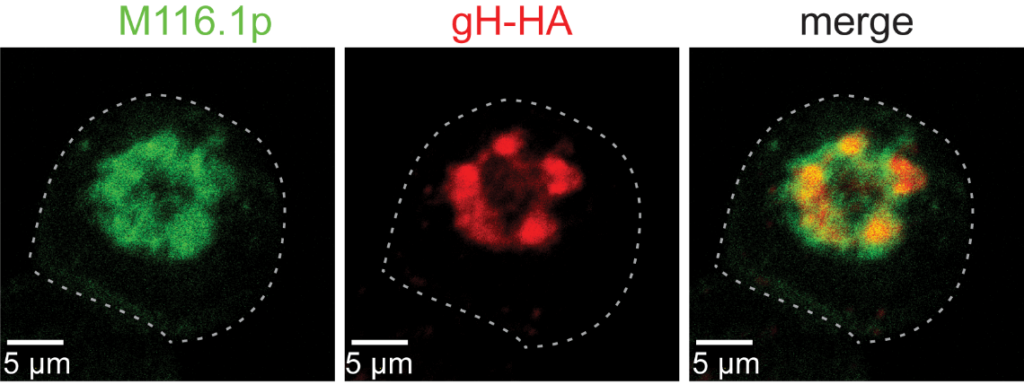
This research group deals with elucidating the function of cytomegalovirus genes during host infection, researching the biology and pathogenesis of cytomegalovirus infection in adrenal glands and microglia, as well as participating in the development of innovative pharmaceutical products with antiviral activity in cooperation with the Jadran Galenic Laboratory. In addition to scientific research, some group members actively participated in the implementation of laboratory diagnostics for the COVID-19 disease for the Clinical Hospital Centre Rijeka. The group is funded by projects from the Croatian Science Foundation, the European Regional Development Fund and the University of Rijeka.
Selected publications:
- Ruzic, T., V. J. Lisnic, H. M. Lucin, T. L. Rovis, J. Zeleznjak, M. C. Brdovcak, A. Vrbanovic, D. Oreb, D. Kvestak, K. G. Jercic, F. Borovecki, P. Lucin, B. Adler, S. Jonjic and B. Lisnic (2022). “Characterization of M116.1p, a Murine Cytomegalovirus Protein Required for Efficient Infection of Mononuclear Phagocytes.” Journal of Virology 96(2).
- Tomac, J.*, M. Mazor*, B. Lisnic*, M. Golemac, D. Kvestak, M. Bralic, L. B. Zulle, M. M. Brinkmann, L. Dolken, L. S. Reinert, S. R. Paludan, A. Krmpotic, S. Jonjic and V. J. Lisnic (2021). “Viral infection of the ovaries compromises pregnancy and reveals innate immune mechanisms protecting fertility.” Immunity 54(7): 1478-+.
- Lisnic, B., J. Tomac, D. Cekinovic, S. Jonjic and V. J. Lisnic (2021). “Rodent Models of Congenital Cytomegalovirus Infection.” Human Cytomegaloviruses, 2 Edition 2244: 365-401.
- Redwood, A. J., L. L. Masters, B. C. Chan, S. Leary, C. Forbes, S. Jonjic, V. J. Lisnic, B. Lisnic# and L. M. Smith# (2020). “Repair of an Attenuated Low-Passage Murine Cytomegalovirus Bacterial Artificial Chromosome Identifies a Novel Spliced Gene Essential for Salivary Gland Tropism.” Journal of Virology 94(22).
- Lisnic, B., V. J. Lisnic and S. Jonjic (2015). “NK cell interplay with cytomegaloviruses.” Current Opinion in Virology 15: 9-18.
CarNanoTBI
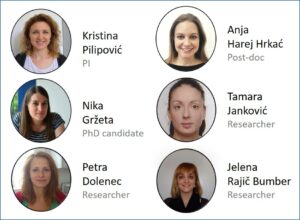
Department of Basic and Clinical Pharmacology and Toxicology
Research group: CarNanoTBI
Assoc. Prof. Kristina Pilipović, MD, PhD
Group members: Nika Gržeta, M.Sc., Anja Harej Hrkać, M.Sc., PhD, Tamara Janković, M.Sc.EPH, PhD, Asst. Prof. Petra Dolenec, PhD,Jelena Rajič Bumber, M.Sc., PhD
This research group, led by Associate Professor Kristina Pilipović, was established as part of the research project from the Croatian Science Foundation “Single-walled carbon nanotubes in experimental traumatic brain injury” (CarNanoTBI). Astrocytes, the most numerous and diverse cells of the central nervous system, are powerful regulators of cellular homeostasis, and evidence suggests a significant role of reactive astrocytosis in synaptic plasticity and reorganisation of neural circuits after traumatic brain injury (TBI). One promising approach that could enable the recovery of the damaged brain after TBI is tissue engineering, which is aimed at bridging structural defects in brain tissue. Carbon nanotubes (CNTs) have numerous peculiarities (size, strength, flexibility, conductivity and biocompatibility) that make them a promising material for numerous biomedical applications. The hypotheses of this project are how chemically functionalised single-walled CNTs promote survival and proliferation and influence the functions of astrocytes exposed to in vitro TBI, and how they support recovery and regeneration after intracerebral application in mice with TBI.
Selected publications:
- Janković T, Dolenec P, Rajič Bumber J, Gržeta N, Križ J, Župan G, Pilipović K. Differential expression patterns of TDP-43 in single moderate versus repetitive mild traumatic brain injury in mice. Int J Mol Sci 2021;22(22):12211. (Q1; IF 5,924)
- Pilipović K, Rajič Bumber J, Dolenec P, Gržeta N, Janković T, Križ J, Župan G. Long-term effects of repetitive mild traumatic injury on the visual system in wild-type and TDP-43 transgenic mice. Int J Mol Sci 2021;22(12):6584. (Q1; IF 5,924)
- Rajič Bumber J, Pilipović K, Janković T, Dolenec P, Gržeta N, Križ J, Župan G. Repetitive traumatic brain injury is associated with TDP-43 alterations, neurodegeneration, and glial activation in mice. J Neuropathol Exp Neurol 2021;80:2–14. (Q1; IF 3,685)
- Dolenec P, Pilipović K, Rajič J, Župan G. Temporal pattern of neurodegeneration, programmed cell death, and neuroplastic responses in the thalamus after lateral fluid percussion brain injury in the rat. J Neuropathol Exp Neurol 2015;74:512-26. (Q1; IF 3,685)
CD8 T-Cell Biology
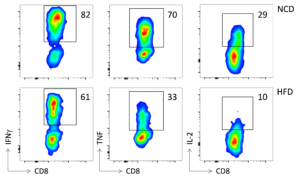
Department of Histology and Embryology
Research group: CD8 T-Cell Biology
Immune-endocrine Interactions
Assoc. Prof. Felix M. Wensveen, PhD
Group members: Inga Kavazović, M.Sc., PhD, Mia Krapić, MSc, Dora Gašparini, MD, Asst. Prof. Tamara Turk Wensveen, MD, PhD
Being sick makes us miserable. For example, appetite is decreased, we get a fever and lose muscle strength. Whereas we experience this as pathology, in fact it is a carefully orchestrated, physiological response mediated by the immune system with the purpose to minimise pathogen replication whilst maximising immune cell activity. How this is mediated is largely unknown. The research of my team focuses on three major topics: 1. How is CD8 T cell biology regulated on a fundamental level? 2. How does the immune system impact endocrine regulation of systemic metabolism? 3. How does endocrine regulation of systemic metabolism impact the immune system? We study these topics in mice using advanced genetic models to study the immune system and dietary models to induce metabolic disease. In addition, we are collaborating with the team of Asst. Prof. Turk Wensveen to collect samples from people with diabetes with the aim of studying these processes in human cells.
Selected publications:
- Kavazović I, Krapić M,Beumer-Chuwonpad A, Polić B, Turk Wensveen T, Lemmermann NA, Van Gisbergen KPJM, Wensveen FM, Hyperglycemia and not hyperinsulinemia mediates diabetes-induced memory cd8 t cell dysfunction, Diabetes. 2022 Jan 14:db210209. (Impact factor 9.5).
- Kavazović I, Han H, Balzaretti G, Slinger E, Lemmermann NAW, Ten Brinke A, Merkler D, Koster J, Bryceson Y, De Vries N, Jonjić S, Klarenbeek PL, Polić B, Eldering E, Wensveen FM, Eomes broadens the scope of CD8 T cell memory by inhibiting apoptosis in cells of low affinity. PLoS Biol. 2020 Mar 17;18(3):e3000648. (Impact factor 8.0).
- Turk Wensveen T, Fučkar Ćupić D, Jurišić Eržen D, Polić B, Wensveen FM, Severe lipoatrophy in a patient with diabetes mellitus type 2 in response to glargine and degludec insulin: Possible involvement of CD4 T cell mediated tissue remodelling. Diabetes Care. 2020 Feb;43(2):494-496. doi: 10.2337/dc19-1888. (Impact factor 19.1).
- Šestan M, Marinović S, Kavazović I, Cekinović Đ, Wueest S, Turk Wensveen T, Brizić I, Jonjić S, Konrad D, Wensveen FM*, Polić B*. Virus-Induced Interferon-γ Causes Insulin Resistance in Skeletal Muscle and Derails Glycemic Control in Obesity. Immunity. 2018 Jul 17;49(1):164-177.e6. doi: 10.1016/j.immuni.2018.05.005. (Impact factor 31.7).
- Kavazović I, Lenartić M, Jelenčić V, Jurković S, Lemmermann NAW, Jonjić S, Polić B, Wensveen FM, NKG2D stimulation of CD8+ T cells during priming promotes their capacity to produce cytokines in response to viral infection in mice. Eur J Immunol. 2017 Jul;47(7):1123-1135. doi: 10.1002/eji.201646805. (Impact factor 5.5).
*Shared senior authorship.
URL: https://sites.google.com/view/tcellmemory
URL (scopus): https://www.scopus.com/authid/detail.uri?authorId=12902681800
European Bioethics
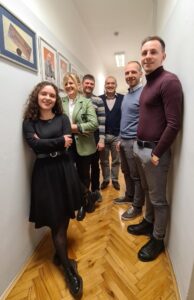
Department of Humanities and Social Sciences in Medicine
Research group: European Bioethics
Prof. Amir Muzur, MD, PhD
Group members: Toni Buterin, M.Sc.EPH, Robert Doričić, PhD, Asst. Prof. Igor Eterović, PhD, Assoc. Prof. Iva Rinčić, PhD, Ivana Tutić Grokša, MA
This research group bases its work on the rich tradition of the Department’s pioneering work on contemporary trends in bioethics. Our research focuses on the promotion of European intellectual thinking and its valorisation in contemporary bioethical issues. The members of the group are also members of the editorial board of the international scientific journal Jahr – European Journal of Bioethics. They have also initiated a number of projects focused on European bioethics that resulted in one HERA project, three Croatian Science Foundation, three University of Rijeka projects, the first international conference Fritz Jahr, the Rijeka Declaration on the Future of Bioethics and the establishment of the Research and Documentation Centre for European Bioethics Fritz Jahr as one of the institutions holding the network of the Scientific Centre of Excellence for Integrative Bioethics. The group members are also regularly involved in the organisation of the longest regular bioethics symposium in the country – the Rijeka Days of Bioethics.
Selected publications:
- Rinčić I, Muzur A. 2019. Fritz Jahr and the Emergence of European Bioethics. Zürich: Lit. (translated from Croatian)
- Muzur A, Rinčić I. 2019. Van Rensselaer Potter and His Place in the History of Bioethics. Zürich: Lit. (translated from Croatian)
- Rinčić I, Muzur A. 2011. Fritz Jahr: the invention of bioethics and beyond. Perspectives in Biology and Medicine 54 (4), 550-556.
- Muzur A, Rinčić I, Sodeke S. 2016. The real Wisconsin Idea: the seven pillars of Van Rensselaer Potter’s bioethics. Journal of Agricultural and Environmental Ethics 29 (4), 587-596.
- Rinčić I, Buterin T, Doričić R, Eterović I, Gensabella M, Muzur A. 2021. The right to exit the footnote: a story of rediscovery and revival of Fritz Jahr’s bioethics (with special regard to Italy). Medicina e morale 1, 11-24.
Physics of Ionising Radiation and Application in Medicine
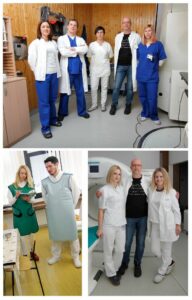
Department of Medical Physics and Radiation Protection of the Clinical Hospital Centre Rijeka / Department of Medical Physics and Biophysics of the Faculty of Medicine in Rijeka
Research group: Physics of Ionising Radiation and Application in Medicine
Assoc. Prof. Slaven Jurković, PhD
The Department of Medical Physics and Radiation Protection researches the physical aspects of ionising radiation and its application in medicine. The research is experimental and its implementation requires sophisticated equipment and researchers with basic training in physics. The group currently consists of nine members divided into subgroups according to their interests and expertise. The equipment was mainly procured through projects funded by the International Atomic Energy Agency (IAEA), which the Department has been implementing for the past 13 years (seven projects). In the last five years, the Department’s dynamic research activity has resulted in the publication of about twenty scientific papers in international journals in the field of medical physics and about thirty conference papers. The group’s research potential has increased over the last five years with the production of two PhD theses. It is planned to further develop this potential in the near future through the defence of the PhD theses by doctoral students in the Doctoral Study of Physics at the Department of Medical Physics and Biophysics of the University of Rijeka.
Selected publications:
- Božanić, Ana; Šegota, Doris; Dundara Debeljuh, Dea; Švabić Kolacio, Manda; Smilović Radojčić, Đeni; Ružić, Katarina; Budanec, Mirjana; Kasabašić, Mladen; Hrepić, Darijo; Valković Zujić, Petra; Brambilla, Marco; Kalra, Mannudeep; Jurković, Slaven. National Reference Levels of CT Procedures dedicated for Treatment Planning in Radiation Oncology, European Journal of Medical Physics, 96 (2022) 123–129, https://doi.org/10.1016/j.ejmp.2022.03.001
- Švabić Kolacio, Manda; Brkić, Hrvoje; Faj, Dario; Smilović Radojčić, Đeni; Rajlić, David; Obajdin; Nevena; Jurković, Slaven. Validation of two calculation options built in Elekta Monaco Monte Carlo based algorithm using MCNP code. Radiation physics and chemistry, 179(2021), 109237, 7
- Dundara Debeljuh, Dea; Jurković, Slaven; Pribanić, Ivan; Poljak, Frano; Kralik, Ivana; Krstonošić, Branislav; Bralić, Ante; Bajan, Tamara; Božac, Ondina; Vidošević, Ljiljana; Kumrić, Danijela; Zrilić, Ivana; Šegota, Doris; Diklić, Ana; Smilović Radojčić, Đeni; Vassileva Jenia. National survey to set diagnostic reference levels in nuclear medicine single photon emission imaging in Croatia, European Journal of Medical Physics, 78 (2020), 109-116
- Smilović Radojčić, Đeni; Casar, Božidar; Rajlić, David; Švabic Kolacio, Manda; Mendez, Ignasi; Obajdin, Nevena; Dundara Debeljuh, Dea; Jurković, Slaven. Experimental validation of Monte Carlo based treatment planning system in bone density equivalent media. Radiology and oncology, 54 (2020), 4; 495-504 doi:10.2478/raon2020-0051)
- Smilović Radojčić, Đeni; Rajlić, David; Casar, Božidar; Švabić Kolacio, Manda; Obajdin, Nevena; Faj, Dario; Jurković, Slaven. Evaluation of two-dimensional dose distributions for pre-treatment patient-specific IMRT dosimetry. Radiology and oncology, 52 (2018), 3; 346-352 doi:10.2478/raon-2018-0019
- Smilović Radojčić, Đeni; Švabić Kolacio, Manda; Radojčić, Milan; Rajlić, David; Casar, Božidar; Faj, Dario; Jurković, Slaven. Comparison of calculated dose distributions reported as dose-to-water and dose-to-medium for intensity-modulated radiotherapy of nasopharyngeal cancer patients. Medical dosimetry. (2017) https://doi.org/10.1016/j.meddos.2017.11.008
Health for All?!
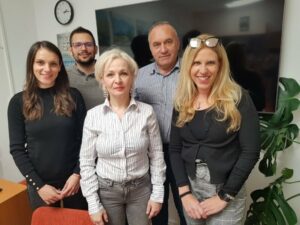
Department of Social Medicine and Epidemiology
Research group: Health for All?!
Prof. Tomislav Rukavina, MD, PhD
Group members: Prof. Tomislav Rukavina, MD, PhD, Assoc. Prof. Vanja Vasiljev, M.Sc.EPH, PhD, Asst. Prof. Lovorka Bilajac, M.Sc.EPH, PhD, Denis Juraga, M.Sc.EPH, Mihaela Marinović Glavić, M.Sc.EPH
This research group covers a range of topics in the field of public health, including research into the effectiveness of community health interventions, health promotion and disease prevention to improve the residents’ quality of life. The current research is conducted within the scientific project ValueCare (Horizon2020). The goal of the project is to develop efficient evidence-based integrated health and social care, primarily targeting elderly people with chronic non-communicable diseases. The project’s vision is to base the concept of healthy ageing on the right of every elderly person to live the highest quality life possible, based on values that should be enabled through quality, personalised, accessible and integrated care. The research group aims to generate knowledge on disease prevention, the discovery of cause-and-effect relationships in the prevention of chronic non-communicable diseases, and personalised health care, using research infrastructure based on modern information and communication technology in an international setting for the transfer and exchange of acquired knowledge and its application in the population.
Selected publications:
- Ožić S, Vasiljev V, Ivković V, Bilajac L, Rukavina T. Interventions aimed at loneliness and fall prevention reduce frailty in elderly urban population. Medicine (Baltimore). 2020 Feb;99(8):e19145. doi: 10.1097/MD.0000000000019145. PMID: 32080091; PMCID: PMC7034624. – WoSCC Q2
- Franse CB, Zhang X, van Grieken A, Rietjens J, Alhambra-Borrás T, Durá E, Garcés-Ferrer J, van Staveren R, Rentoumis T, Markaki A, Bilajac L, Vasiljev Marchesi V, Rukavina T, Verma A, Williams G, Clough G, Koppelaar E, Martijn R, Mattace Raso F, Voorham AJJ, Raat H. A coordinated preventive care approach for healthy ageing in five European cities: A mixed methods study of process evaluation components. J Adv Nurs. 2019 Dec;75(12):3689-3701. doi: 10.1111/jan.14181. Epub 2019 Oct 6. PMID: 31441529. – WoSCC Q1
- Zhang X, Tan SS, Fierloos I, Zanutto O, Alhambra-Borrás T, Vasiljev V, Bennett S, Rentoumis T, Buranello A, Macchione S, Rouwet E, van Grieken A, Raat H. Evaluation design of the Social Engagement Framework for Addressing the Chronic-disease-challenge (SEFAC): a mindfulness-based intervention to promote the self-management of chronic conditions and a healthy lifestyle. BMC Public Health. 2019 May 30;19(1):664. doi: 10.1186/s12889-019-6979-7. PMID: 31146709; PMCID: PMC6543603. – Scopus Q1
- Franse CB, van Grieken A, Alhambra-Borrás T, Valía-Cotanda E, van Staveren R, Rentoumis T, Markaki A, Bilajac L, Marchesi VV, Rukavina T, Verma A, Williams G, Koppelaar E, Martijn R, Voorham AJJ, Mattace Raso F, Garcés-Ferrer J, Raat H. The effectiveness of a coordinated preventive care approach for healthy ageing (UHCE) among older persons in five European cities: A pre-post controlled trial. Int J Nurs Stud. 2018 Dec;88:153-162. doi: 10.1016/j.ijnurstu.2018.09.006. Epub 2018 Sep 8. PMID: 30296635. – WoSCC Q1
- Franse CB, Voorham AJJ, van Staveren R, Koppelaar E, Martijn R, Valía-Cotanda E, Alhambra-Borrás T, Rentoumis T, Bilajac L, Marchesi VV, Rukavina T, Verma A, Williams G, Clough G, Garcés-Ferrer J, Mattace Raso F, Raat H. Evaluation design of Urban Health Centres Europe (UHCE): preventive integrated health and social care for community-dwelling older persons in five European cities. BMC Geriatr. 2017 Sep 11;17(1):209. doi: 10.1186/s12877-017-0606-1. PMID: 28893178; PMCID: PMC5594491. – Scopus Q1
Immunobiology and Pathogenesis of Early-Life Viral Infections
Centre for Proteomics
Research group: Immunobiology and Pathogenesis of Early-Life Viral Infections
Asst. Prof. Ilija Brizić, PhD
Group members: Prof. Stipan Jonjić, MD, PhD, Marina Pribanić Matešić, PhD, Carmen Rožmanić, M.Sc. (PhD student), Fran Krstanović, M.Sc. (PhD student), Andrea Mihalić, M.Sc. (PhD student)
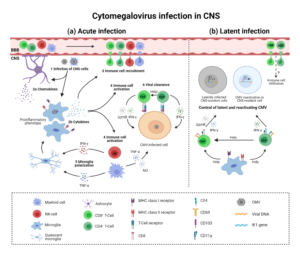
This research group focuses on two research directions: 1) the pathogenesis of congenital cytomegalovirus infection in the central nervous system and 2) the effects of early-life infections on the remodelling of innate immune cells. The first direction investigates congenital cytomegalovirus infection, which is the main cause of transplacentally transmitted congenital infections that can cause a wide spectrum of structural and functional damage and permanent neurological consequences. The main goals of this research are to identify the mechanisms of damage to the nervous system and the mechanisms of immune control during the acute phase of infection and cytomegalovirus latency in the nervous system. The second direction investigates how innate lymphoid NK and ILC1 cells contribute to infection control in the perinatal period and how infection affects the development of these cells. The research is being conducted within the framework of two projects funded by the Croatian Science Foundation and the European Social Fund, within one project of the Excellence Centre for Viral Immunology and Vaccines and thanks to the support of the University of Rijeka.
Selected publications:
- Rožmanić C, Lisnić B, Pribanić Matešić M, Mihalić A, Hiršl L, Park E, Lesac Brizić A, Indenbirken D, Viduka I, Šantić M, Adler B, Yokoyama WM, Krmpotić A, Juranić Lisnić V, Jonjić S, Brizić I. (2023) Perinatal murine cytomegalovirus infection reshapes the transcriptional profile and functionality of NK cells. Nat Commun. 19(12):e1011793.
- Brlić PK, Pavletić M, Lerga M, Krstanović F, Matešić MP, Miklić K, Malić S, Mikša L, Pajcur M, Peruč D, Schubert M, Bertoglio F, Arapović J, Protić A, Šustić A, Milošević M, Šain LČ, Jonjić S, Lisnić VJ, Brizić I. (2023) SARS-CoV-2 Spike and Nucleocapsid Antibody Response in Vaccinated Croatian Healthcare Workers and Infected Hospitalized Patients: A Single Center Cohort Study. Viruses. 14(9):1966.
- Brizić I, Lisnić B, Brune W, Hengel H, Jonjić S. (2022) Mouse Models for Cytomegalovirus Infections in Newborns and Adults. Curr Protoc. 2(9):e537.
- Piersma SJ, Brizić I. (2021) Natural killer cell effector functions in antiviral defense. FEBS J. doi: 10.1111/febs.16073.
- Brizić I, Šušak B, Arapović M, Huszthy PC, Hiršl L, Kveštak D, Juranić Lisnić V, Golemac M, Pernjak Pugel E, Tomac J, Oxenius A, Britt WJ, Arapović J, Krmpotić A, Jonjić S. (2018) Brain-resident memory CD8+ T cells induced by congenital CMV infection prevent brain pathology and virus reactivation. Eur J Immunol. 48(6):950-964.
Cell Physiology Research Group

Cell Physiology Research Group
Department of Physiology, Immunology and Pathophysiology
This group investigates physiological mechanisms and membrane trafficking routes in the endosomal system and Golgi apparatus. The main research focus is to clarify the mechanisms by which cytomegalovirus rearranges the cell membrane in the early phase of infection and leads to the formation of a cytoplasmic virion assembly compartment (cVAC), and to identify membrane organelles where the secondary evelopment of newly formed viruses occurs. The group’s work is organised through three projects financed by the Croatian Science Foundation: Secondary Envelopment and Egress of Beta-Herpesvirus From the Cell (IP-2019-04-9564, project supervisor Prof. Pero Lučin, PhD), Reorganisation of the interface between early endosomes and endosomal recycling compartment in cytomegalovirus infection (IP-2020-02-2916, project supervisor Prof. Hana Mahmutefendić Lučin) and the Arf GTPases in the Pathogenesis of Cytomegalovirus Infection (IP-2020-02-1323, project supervisor Prof. Gordana Blagojević Zagorac).
Selected publications:
- Lučin P., Karleuša Lj., Blagojević Zagorac G., Mahmutefendić Lučin H., Pavišić V., Jug Vučko N., Lukanović Jurić S., Marcelić M., Lisnić B., Jonjić S. (2018). Cytomegaloviruses exploit recycling Rab proteins in the sequential establishment of the assembly compartment. Frontiers in Cell and Developmental Biology. https://doi.org/10.3389/fcell.2018.00165.
- Lučin P., Jug Vučko N., Karleuša Lj., Mahmutefendić Lučin H., Blagojević Zagorac G., Lisnić B., Pavišić V., Marcelić M., Grabušić K., Brizić I., Lukanović Jurić S. (2020). Cytomegalovirus generates assembly compartment in the early phase of infection by perturbation of host-cell factors recruitment at the early endosome/endosomal recycling compartment/trans-Golgi interface. Frontiers in Cell and Developmental Biology, 8:563607. https://doi.org/10.3389/fcell.2020.563607.
- Štimac, I.; Jug Vučko, N.; Blagojević Zagorac, G.; Marcelić, M.; Mahmutefendić Lučin, H.; Lučin, P. (2021). Dynamin Inhibitors Prevent the Establishment of the Cytomegalovirus Assembly Compartment in the Early Phase of Infection. Life 2021, 11, 876. https://doi.org/10.3390/life11090876
- Pavišić V, Mahmutefendić Lučin H, Blagojević Zagorac G, Lučin P. (2021). Arf GTPases Are Required for the Establishment of the Pre-Assembly Compartment in the Early Phase of Cytomegalovirus Infection. Life. 2021; 11(8):867. https://doi.org/10.3390/life11080867
- Marcelić M, Lučin HM, Begonja AJ, Zagorac GB, Lisnić VJ, Lučin P. (2021). Endosomal Phosphatidylinositol-3-Phosphate-Associated Functions Are Dispensable for Establishment of the Cytomegalovirus Pre-Assembly Compartment but Essential for the Virus Growth. Life. 2021; 11(8):859. https://doi.org/10.3390/life11080859
Cytomegalovirus Immune Evasion
Department of Histology and Embryology
Research group: Cytomegalovirus Immune Evasion
Prof. Astrid Krmpotić, MD, PhD
Group members: Maja Cokarić Brdovčak, PhD, Asst. Prof. Irena Slavuljica, MD, PhD, Prof. Jelena Tomac, MD, PhD, Marko Šustić, MD, PhD, Jelena Materljan, MD (PhD student), Lydia Gaćina, M.Sc. (PhD student), Dijana Rumora, B.Sc.MLD
This research group explores the immunobiology of cytomegalovirus (CMV) infection using the murine CMV (MCMV) model, with special emphasis on the mechanisms by which CMV evades the host immune response. Since MCMV negatively regulates the expression of ligands for several costimulatory CD8 T lymphocyte receptors, this group, together with Dr Annette Oxenius’ group from ETH Zurich, is investigating the clonal dynamics of memory CD8 T lymphocyte inflation, with an emphasis on the role of costimulatory molecules, as part of the Croatian-Swiss research program. As part of the Croatian Science Foundation project, they are examining the possibility of using recombinant CMV expressing the ligand for the NKG2D activation as a vaccine to prevent congenital CMV infection, focusing on the virus expressing the H60 ligand. As part of the IP-CORONA project of the Croatian Science Foundation, they are also working on the development of a cytomegalovirus vaccine vector for SARS-CoV-2. As part of the UNIRI project of the University of Rijeka, they are also investigating how CMV avoids immunosurveillance mediated by the NCR1 receptor.
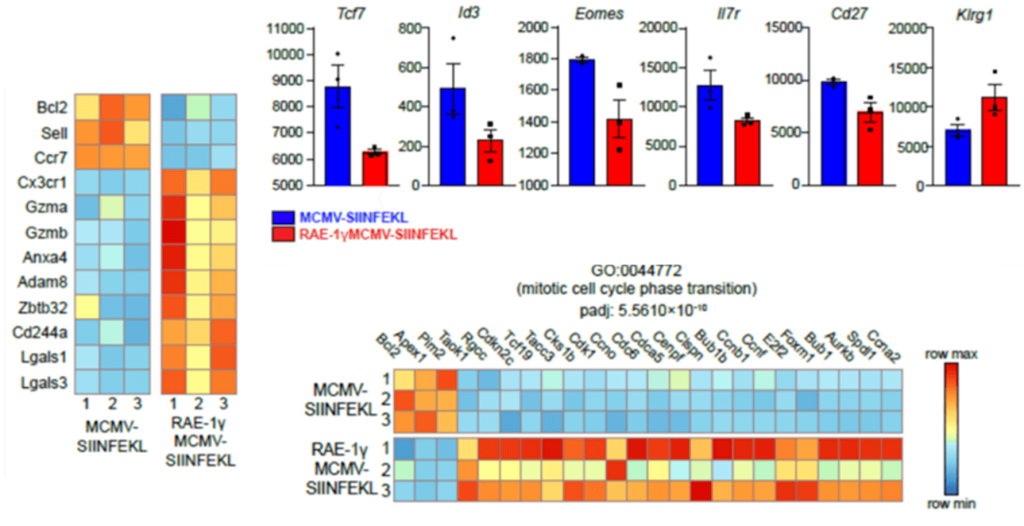
Selected publications:
- Brdovčak MC, Materljan J, Šustić M, Ravlić S, Ružić T, Lisnić B, Miklić K, Brizić I, Matešić MP, Lisnić VJ, Halassy B, Rončević D, Knežević Z, Štefan L, Bertoglio F, Schubert M, Čičin-Šain L, Markotić A, Jonjić S, Krmpotić A. ChAdOx1-S adenoviral vector vaccine applied intranasally elicits superior mucosal immunity compared to the intramuscular route of vaccination. European Journal of Immunology. 2022.
- Šustić M, Cokarić Brdovčak M, Lisnić B, Materljan J, Juranić Lisnić V, Rožmanić C, Indenbirken D, Hiršl L, Busch DH, Brizić I, Krmpotić A, Jonjić S. Memory CD8 T cells generated by cytomegalovirus vaccine vector expressing NKG2D ligand have effector-like phenotype and distinct functional features. Frontiers in Immunology. 12:681380, 2021.
- Angulo G, Zeleznjak J, Martínez-Vicente P, Puñet-Ortiz J, Hengel H, Messerle M, Oxenius A, Jonjic S, Krmpotic A, Engel P, Angulo A. Cytomegalovirus restricts ICOSL expression on antigen presenting cells disabling T cell co-stimulation and contributing to immune evasion. Elife. 10:e59350, 2021.
- Aguilar OA, Berry R, Rahim MM, Reichel JJ, Popović B, Tanaka M, Fu Z, Balaji GR, Lau TN, Tu MM, Kirkham CL, Mahmoud AB, Mesci A, Krmpotić A, Allan DS, Makrigiannis AP, Jonjić S, Rossjohn J, Carlyle JR. A Viral Immunoevasin Controls Innate Immunity by Targeting the Prototypical Natural Killer Cell Receptor Family. Cell. 169(1):58-71, 2017.
- Miletic A, Lenartic M, Popovic B, Brizic I, Trsan T, Miklic K, Mandelboim O, Krmpotic A*, Jonjic S*. NCR1-deficiency diminishes the generation of protective murine cytomegalovirus antibodies by limiting follicular helper T-cell maturation. European Journal of Immunology. 47(9):1443-1456, 2017.
Mechanisms of Anti-Inflammatory and Antitumour Activity of Phytochemicals

Department of Medical Chemistry, Biochemistry and Clinical Chemistry
Research group: Mechanisms of Anti-Inflammatory and Antitumour Activity of Phytochemicals
Prof. Robert Domitrović, PhD
Group members: Assoc. Prof. Dijana Detel, MD, PhD, Assoc. Prof. Lara Batičić, PhD, Iva Potočnjak, PhD, Iva Vukelić, PhD, Sunčica Buljević, PhD, Lidija Šimić, M.Sc.EPH
This group explores the mechanisms of the therapeutic effect of phytochemicals on cellular and animal models of toxic kidney injury and colon cancer. Phytochemicals are pharmacologically active substances that act not only as antioxidants but also as modulators of cellular signalling pathways. Their research focuses on apoptosis and autophagy/mitophagy and the signalling pathways involved in these processes. They are particularly interested in colon cancer cell chemosensitisation to chemotherapeutic agents. Also, they are planning on using nanoencapsulation of phytochemicals in research to increase their bioavailability, especially pH-sensitive nanoparticles in the treatment of colon cancer.
Selected publications:
- Potočnjak, Iva; Šimić, Lidija; Gobin, Ivana; Vukelić, Iva; Domitrović, Robert. Antitumor activity of luteolin in human colon cancer SW620 cells is mediated by the ERK/FOXO3a signaling pathway. Toxicology in Vitro, 66 (2020), 104852.
- Vukelić, Iva; Detel, Dijana; Batičić, Lara; Potočnjak, Iva; Domitrović, Robert. Luteolin ameliorates experimental colitis in mice through ERK-mediated suppression of inflammation, apoptosis and autophagy. Food and Chemical Toxicology, 145 (2020), 111680, 14.
- Potočnjak, Iva; Marinić, Jelena; Batičić, Lara; Šimić, Lidija; Broznić, Dalibor; Domitrović, Robert. Aucubin protects against cisplatin-induced acute kidney injury in mice via attenuation of oxidative stress, apoptosis and inflammation. Food and Chemical Toxicology, 142 (2020), 111472.
- Potočnjak, Iva; Šimić, Lidija; Vukelić, Iva; Domitrović, Robert. Oleanolic acid attenuates cisplatin-induced nephrotoxicity in mice through regulation of multiple signaling pathways. Food and Chemical Toxicology, 132 (2019), 110676.
- Vukelić, Iva; Detel, Dijana; Batičić Pučar, Lara; Potočnjak, Iva; Buljević, Sunčica; Domitrović, Robert.
Chlorogenic acid ameliorates experimental colitis in mice by suppressing signaling pathways involved in inflammatory response and apoptosis. Food and Chemical Toxicology, 121 (2018), 140-150.
Neuroimmunomodulation in Patients With Severe Traumatic Brain Injury and Haemorrhagic Stroke

Research group: Neuroimmunomodulation in Patients With Severe Traumatic Brain Injury and Haemorrhagic Stroke
Group members: Prof. Alan Šustić, MD, PhD, Assoc. Prof. Vlatka Sotošek, MD, PhD, Assoc. Prof. Kristina Grabušić, PhD, Janja Tarčuković, MD, PhD, Lara Valenčić, MD, Matija Sošić, MD, PhD
This group is concerned with the study of changes in the blood and cerebrospinal fluid of patients with severe traumatic brain injury and haemorrhagic stroke. Severe traumatic brain injury and extensive haemorrhagic stroke are life-threatening conditions in which cerebral structure and function have been damaged. Brain injury that occurs in these patients triggers a whole series of cascade reactions that lead to damage to brain cells, which results in secondary brain injury. Damage to cerebral structures is also reflected at the systemic level, and in these patients, the course of treatment is often complicated by the development of systemic infections.
This research group is investigating the complex mechanisms that occur at the systemic and local levels immediately after brain injury and during patient treatment. The research mainly focuses on the analysis of dynamic changes in immune factors and extracellular vesicles in patients’ cerebrospinal fluid and blood and their role in complex pathophysiological events. This group is investigating the potential role of soluble factors and extracellular vesicles as potential biomarkers for the prognosis and treatment of patients with brain injury.
Selected publications:
- Mrakovcic-Sutic I,Sotosek Tokmadzic V, Laskarin G, Mahmutefendic H, Lucin P, Zupan Z, SusticA. Early changes in frequency of peripheral blood lymphocyte subpopulations in severe traumatic brain-injured patients. Scand J Immunol 2010;72:57-65.
- Sotosek Tokmadzic V, Laskarin G, Mahmutefendic H, Lucin P, Mrakovcic-Sutic I,Zupan Z, SusticA. Expression of cytolytic protein – perforin – in peripheral blood lymphocytes in severe traumatic brain injured patients. Injury, Int. J. Care Injured 2012;43:624-31.
- Kuharić J, Grabusic K, Sotosek Tokmadzic V, Štifter S, Tulić K, Shevchuk O, Lučin P, Šustić A. Severe traumatic brain injury induces early changes in the physical properties and protein composition of intracranial extracellular vesicles. J Neurotrauma 2019; 15;36(2):190-200. doi: 10.1089/neu.2017.5515.
- Matas M, Sotošek V, Kozmar A, Likić R, Sekulić A. Effect of local anesthesia with lidocaine on perioperative proinflammatory cytokine levels in plasma and cerebrospinal fluid in cerebral aneurysm patients: Study protocol for a randomized clinical trial. Medicine (Baltimore) 2019;98(42):e17450.
- Sošić M, Antončić I, Tarčuković J, Dunatov S, Šustić A, Ćurko-Cofek B, Sotošek V. Effect of intraventricularly administered low-dose recombinant tissue plasminogen activator on interleukin 1-beta and transforming growth factor beta concentrations in cerebrospinal fluid of patients with primary intracerebral hemorrhage associated with intraventricular hemorrhage: A retrospective study.Medicine (Baltimore) 2020;99(20):e19966.
Pathogenesis of Cytomegalovirus Infection and Immune Response in the Ovaries
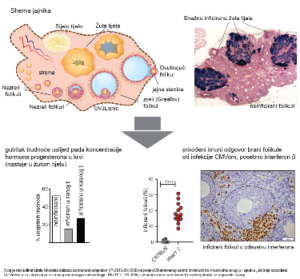
Centre for Proteomics
Research group: Pathogenesis of Cytomegalovirus Infection and Immune Response in the Ovaries
Assoc. Prof. Vanda Juranić Lisnić, PhD
Group members: Jelena Marija Mazor, PhD, Jelena Železnjak, PhD, Magdalena Medved (PhD student), Tina Ružić, M.Sc., Assoc. Prof. Berislav Lisnić, PhD
This group investigates the pathogenesis of cytomegalovirus infection and the immune response in the ovaries, and the mechanisms by which cytomegaloviruses modulate antigen presentation. In 2020 and 2021, in cooperation with the Clinical Hospital Centre Rijeka, the group performed the diagnostics for SARS-CoV-2 infection at the Center for Proteomics of the Faculty of Medicine in Rijeka for the needs of the Clinical Hospital Centre Rijeka and developed a Point-of-Care adaptation of qPCR, which they implemented in the daily work of the Clinical Hospital Centre Rijeka at the Sušak Emergency Hospital in the Laboratory for Rapid Molecular Diagnostics in Emergency Medicine. From 2017 to February 2022, this project’s supervisor implemented one project of the Croatian Science Foundation, one large collaborative project of the German Science Foundation as a co-supervisor, and four grants from the University of Rijeka, all totalling approximately 260,000 EUR.
Selected publications:
- Pavletić M, Mazor M, Lerga M, Mileta T, Železnjak J, Ružić T, Ravlić S, Palčevski D, Kirinčić J, Mežnarić S, Mišković A, Materljan M, Šustić A, Lisnić B, Juranić Lisnić V. (2021). Fast, Reliable, and Simple Point-of-Care-like Adaptation of RT-qPCR for the Detection of SARS-CoV-2 for Use in Hospital Emergency Departments. Viruses, 13(12), 2413.
- Tomac J, Mazor M, Lisnić B, Golemac M, Kveštak D, Bralić M, Bilić Zulle L, Brinkmann MM, Dölken L, Reinert LS, Paludan SR, Krmpotić A, Jonjić S, Juranić Lisnić V. (2021). Viral infection of the ovaries compromises pregnancy and reveals innate immune mechanisms protecting fertility. Immunity 54(7):1478-93.e6.
- Železnjak J*, Lisnić VJ*, Popović B, Lisnić B, Babić M, Halenius A, L’Hernault A, Roviš TL, Hengel H, Erhard F, Redwood AJ, Vidal SM, Dölken L, Krmpotić A, Jonjić S. (2019).The complex of MCMV proteins and MHC class I evades NK cell control and drives the evolution of virus-specific activating Ly49 receptors.J Exp Med. 5;216(8):1809-1827.
- Goodier MR, Jonjić S, Riley EM, Juranić Lisnić V. (2018). CMV and natural killer cells: shaping the response to vaccination. Eur J Immunol. 48(1):50-65.
- Zeleznjak J, Popovic B, Krmpotic A, Jonjic S, Lisnic VJ. (2017.). Mouse cytomegalovirus encoded immunoevasins and evolution of Ly49 receptors – Sidekicks or enemies? Immunol Lett.;189:40-47
Pathogenesis of Medically Important Bacterial Infections
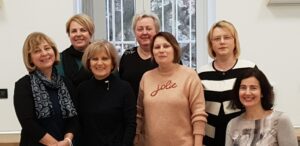
Department of Microbiology and Parasitology
Research group: Pathogenesis of Medically Important Bacterial Infections
Prof. Maja Abram, MD, PhD
Group members: Prof. Darinka Vučković, MD, PhD, Prof. Brigita Tićac, MD, PhD, Assoc. Prof. Ivana Gobin, M.Sc.EPH, PhD, Prof. Marina Bubonja Šonje, MD, PhD, Dolores Peruč, MD, PhD, Davorka Repić, MD
This multidisciplinary research group has been working for years on experimental bacteriology, i.e., the pathogenesis of medically important bacterial infections, and has achieved results at an international level. Their scientific activities focus on the identification and examination of the genetic, functional and structural characteristics of selected bacteria (Listeria, Campylobacter, Pseudomonas, etc.), including the ability to form biofilms and bacterial communication, interactions between different bacteria and immunological interactions between hosts and pathogens. The group examines the bacterial diversity, population structure and antimicrobial resistance of clinically important biofilms using traditional microbiological methods, sonication and culturomics, and molecular techniques including next-generation sequencing. The group is actively researching novel, alternative approaches to formation inhibition and destruction of the bacterial biofilm of selected bacteria. The group is also investigating the effect of natural agents (essential oils, plant extracts and phytochemicals), antibiotics, disinfectants and their combinations and the photodynamic effect of different molecules (porphyrins, zinc oxide microparticles) on the biofilm of multidrug-resistant pathogens. By understanding the mechanisms of bacterial virulence, the group strives to define new targets for effective prevention and antimicrobial therapy, as well as new approaches in sanitation.
Selected publications:
- Klančnik, Anja; Gobin, Ivana; Jeršek, Barbara; Smole Možina, Sonja; Vučković, Darinka; Tušek Žnidarič, Magda; Abram, Maja. Adhesion of Campylobacter jejuni Is Increased in Association with Foodborne Bacteria. Microorganisms. 2020;8:201, 14 doi:10.3390/microorganisms8020201
- Bubonja-Šonje, Marina; Matovina, Mihaela; Škrobonja, Ivana; Bedenić, Branka; Abram, Maja. Mechanisms of carbapenem resistance in multi drug resistant clinical isolates of Pseudomonas aeruginosa from a Croatian hospital. Microbial drug resistance-mechanisms epidemiology and disease. 2015;21(3): 261-269 doi:10.1089/mdr.2014.0172
- Bubonja Sonje, Marina; Giacometti, Jasminka; Abram, Maja. Antioxidant and antilisterial activity of olive oil, cocoa and rosemary extract polyphenols. Food chemistry. 2011;127(4):1821-1827 doi:10.1016/j.foodchem.2011.02.071
- Mihaljević, Roberta; Šikić, Maja; Klančnik, Anja; Brumini, Gordana; Smole Možina, Sonja; Abram, Maja. Environmental stress factors affecting survival and virulence of Campylobacter jejuni. Microbial Pathogenesis. 2007;43 (2-3):120-125
- Bubonja, Marina; Wraber, Branka; Brumini, Gordana; Gobin, Ivana; Veljković, Danijela; Abram, Maja. Systemic and Local CC Chemokines Production in a Murine Model of Listeria monocytogenes Infection. Mediators of inflammation. 2006; 2006(3):54202. doi: 10.1155/MI/2006/54202.
Pathogenesis of Tularemia and Legionnaires’ Disease

Department of Microbiology and Parasitology
Research group: Pathogenesis of Tularemia and Legionnaires’ Disease
Prof. Marina Šantić, M.Sc.EPH, PhD
Group members: Asst. Prof. Mateja Ožanič, M.Sc.EPH, PhD, Asst. Prof. Mirna Mihelčić, DVM, PhD, Valentina Marečić, M.Sc.EPH, PhD, Ina Viduka, M.Sc.EPH, Maša Knežević, M.Sc.
The research field focuses on the cell biology and pathogenesis of tularemia and Legionnaires’ disease. Francisella tularensis is a gram-negative, highly infectious, facultative intracellular bacterium that causes tularemia in animals and humans. The bacterium Legionella pneumophila invades and multiplies in macrophage cells, causing atypical pneumonia known as Legionnaires’ disease. In the aquatic environment, Legionella reproduces within the amoeba, which is essential for transmission to humans. This research group is examining the mechanisms of host cell biology exploitation by the two mentioned intracellular bacterial pathogens, which is essential for understanding the pathogenesis of the diseases. The main research topics are the molecular mechanisms of maturation of intracellular compartments (phagosomes and vacuoles) in the autophagy process, the mechanisms of immune interaction between host and pathogen, the mechanisms of cell death and the ability to survive in amoebae over a long period. The main focus is on understanding the virulence factors that allow Legionella and Francisella to manipulate host cell biology and proliferate intracellularly. These bacterial factors are potential targets for new antibiotics, for prevention and for vaccination. The research includes in vitro and in vivo infection models, as well as environmental and human samples.
Selected publications:
- Knežević M, Rončević D, Vukić Lušić D, Mihelčić M, Kogoj R, Keše D, Glad M, Cenov A, Ožanič M, Glažar Ivče D, Šantić M. Decreasing Pasteurization Treatment Efficiency against Amoeba-Grown Legionella pneumophila-Recognized Public Health Risk Factor. Int J Environ Res Public Health. 2022 Jan 19;19(3):1099. doi: 10.3390/ijerph19031099.
- Ozanic M, Marecic V, Knezevic M, Kelava I, Stojková P, Lindgren L, Bröms JE, Sjöstedt A, Abu Kwaik Y, Santic M. The type IV pili component PilO is a virulence determinant of Francisella novicida. PLoS One. 2022 Jan 25;17(1):e0261938. doi: 10.1371/journal.pone.0261938.
- Kelava I, Mihelčić M, Ožanič M, Marečić V, Knežević M, Ćurlin M, Štifter S, Sjöstedt A, Šantić M. Atg5-Deficient Mice Infected with Francisella tularensis LVS Demonstrate Increased Survival and Less Severe Pathology in Internal Organs. Microorganisms. 2020 Oct 6;8(10):1531.
- Marecic V, Shevchuk O, Ozanic M, Mihelcic M, Steinert M, Jurak Begonja A, Abu Kwaik Y, Santic M. Isolation of F. novicida-Containing Phagosome from Infected Human Monocyte Derived Macrophages. Front Cell Infect Microbiol. 2017 Jul 5;7:303. doi: 10.3389/fcimb.2017.00303. eCollection 2017.
- Ozanic M, Marecic V, Abu Kwaik Y, Santic M. The Divergent Intracellular Lifestyle of Francisella tularensis in Evolutionarily Distinct Host Cells.PLoS Pathog. 2015 Dec 3;11(12):e1005208. doi: 10.1371/journal.ppat.1005208. eCollection 2015 Dec.
History of Medicine
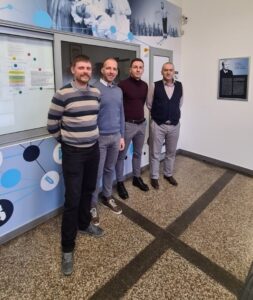
Department of Humanities and Social Sciences in Medicine
Research group: History of Medicine
Prof. Amir Muzur, MD, PhD
Group members: Toni Buterin, M.Sc.EPH, Robert Doričić, PhD, Asst. Prof. Igor Eterović, PhD
The research group bases its work on the rich tradition of Rijeka’s school of history of medicine. The group’s research focuses on the past of health care in Rijeka and the wider region, as well as on the contribution of Rijeka’s medical professionals to the progress of the profession at the national and international levels. The members of the group are also members of the editorial board of the scientific journal AMHA – Acta medico-historico Adriatica, co-published by the Croatian Scientific Society for the History of Health Culture and the Faculty of Medicine in Rijeka, and the editorial board of the book series Alumni MedRi Library dedicated to the scientific and other achievements of the Faculty’s alumni. Among the most significant projects is the exhibition on the occasion of the 65th anniversary of the founding of the Faculty and the project Oral History of the Faculty of Medicine in Rijeka. The group pays special attention to the preservation and continuous enrichment of the collection of items from the legacy of renowned individuals in Rijeka’s history of medicine. By (co)organising exhibitions and book promotions, the group members regularly participate in the programme of the Faculty of Medicine Days.
Selected publications:
- Muzur A. 2013. Nezavršena povijest medicine u Rijeci: priča o gradu, ljudima i profesiji. Rijeka: Medicinski fakultet Sveučilišta u Rijeci/Hrvatsko znanstveno društvo za povijest zdravstvene kulture/Naklada Kvarner.
- Muzur A. 2014. Skica za povijest ljekarništva u Rijeci: od najranijih početaka do kraja Drugog svjetskoga rata. Farmaceutski glasnik 70 (11), 827-837.
- Doričić R, Buterin T, Eterović I, Muzur A. 2019. Rijeka and Its surroundings in 1918-1919: The public impact and the image of the epidemic. History in Flux 1, 123-133.
- Buterin T, Glažar B, Muzur, A. 2019. Zvonimir Maretić (1921-1989): The history of discovery of the first European antilatrodectic serum and its preparator on the occasion of the 30th anniversary of his death. Acta medico-historica Adriatica 17 (2), 285-294.
- Kranjčević J, Muzur A. 2020. Vojna lječilišta na Kvarneru u Austrougarskoj monarhiji i briga za unapređenje časničkog zdravlja. Acta medico-historica Adriatica 18 (1), 129-148.
Detection and Immune Response to Cellular Stress Caused by Metabolic Changes and Viral Infections
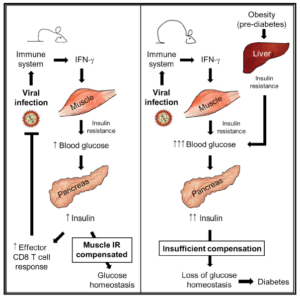
Department of Histology and Embryology
Research group: Detection and Immune Response to Cellular Stress Caused by Metabolic Changes and Viral Infections
Prof. Bojan Polić, MD, PhD
Group members: Marko Šestan, DVM, PhD, Vedrana Jelenčić, PhD, Asst. Prof. Maja Lenartić, PhD, Ante Benić, M.Sc., Karlo Mladenić, M.Sc., Sanja Mikašinović, M.Sc., Vanna Imširović, M.Sc.
This research group conducts basic and translational research in the field of immunology. Their main research topics are as follows: 1. the role of the NKG2D receptor in the development, homeostasis and executive functions of immune cells; 2. mechanisms of immune recognition of metabolic stress and the development of chronic inflammatory diseases; 3. mechanisms of interaction between immune and endocrine systems in viral infections. This research group has developed conventional and conditional NKG2D-deficient mice that are used in their research. The research results indicate the important role of NKG2D in the control of the activity of other activating receptors (NKp46 and CD16) and the education of NK cells during their development. It is a new mechanism of NK cell education that is independent of the standard education method that uses inhibitory receptors. In addition, the group demonstrated the role of NKG2D in the generation of memory CD8+ T lymphocytes in response to viral infections, as well as in the early development of B1 lymphocytes. The group cooperates with several international scientific groups, which resulted in numerous significant scientific publications. In addition, the group is also investigating the mechanisms of immune recognition of metabolic stress in obesity, which leads to chronic inflammatory diseases such as type 2 diabetes and MAFLD. The group found that obesity leads to metabolic stress in adipocytes, which is manifested by increased expression of NKp46 ligands. This activates NK cells in visceral adipose tissue, leading to the secretion of IFNg, which triggers inflammation and systemic insulin resistance. In the context of this topic, the group is investigating the mechanism of early immune system activation in the model for MAFLD, where the NKG2D receptor and gd T lymphocytes play an important role in stress recognition and disease development. In the last several years, the group has also been investigating the mechanisms of interaction between the immune and endocrine systems in viral infections and how these interactions act to control blood glucose and defend against viral infection. The group has discovered that IFNg induced by a mild viral infection leads to insulin resistance in skeletal muscles. This leads to compensatory hyperinsulinaemia to maintain euglycaemia and enhance the CD8+ T cell-mediated antiviral response. However, in persons with prediabetes, this mechanism leads to hyperglycaemia and the development of type 2 diabetes.
Selected publications:
- Zafirova B, Mandarić S, Antulov R, Krmpotić A, Jonsson H, Yokoyama WM, Jonjić S, Polić B. (2009) Altered NK cell development and enhanced NK cell-mediated resistance to mouse cytomegalovirus in NKG2D-deficient mice. Immunity 31:270 – 282
- Wensveen FM, Lenartić M, Jelenčić V, Lemmermann NAW, ten Brinke A, Jonjić S, and Polić B (2013) NKG2D Induces Mcl-1 Expression and Mediates Survival of CD8 Memory T Cell Precursors via Phosphatidylinositol 3-Kinase. J Immunol. 191:1307-15.
- Wensveen FM, Jelenčić V, Valentić S, Šestan M, Wensveen TT, Theurich S, Glasner A, Mendrila D, Štimac D, Wunderlich FT, Brüning JC, Mandelboim O, Polić B. (2015) NK cells link obesity-induced adipose stress to inflammation and insulin resistance. Nat. Immunol. 16:376-385.
- Šestan M, Marinović S, Kavazović I, Cekinović Đ, Wueest S, Turk Wensveen T, Brizić I, Jonjić S, Konrad D, Wensveen FM, Polić B. (2018) Virus-Induced Interferon-γ Causes Insulin Resistance in Skeletal Muscle and Derails Glycemic Control in Obesity. Immunity 49:164-177
- Jelenčić V., Šestan M., Kavazović I., Lenartić M., MarinovićS., Holmes T.D., Prchal-Murphy M., Lisnić B., Sexl V., Bryceson Y.T., Wensveen F.M., Polić B. (2018) NK cell receptor NKG2D sets activation threshold for the NCR1receptor early in NK cell development. Nat. Immunol. 19:1083–1092
Cell Growth
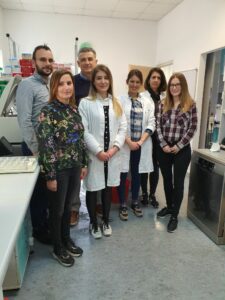
Department of Molecular Medicine and Biotechnology
Research group: Cell Growth
Prof. Siniša Volarević, MD, PhD
Group members: Asst. Prof. Slađana Bursać, M.Sc.EPH, PhD, Milorad Zjalić, PhD (Postdoctoral Researcher), Katarina Budić, M.Sc. (PhD student), Ivana Matušić, M.Sc.MLD, Miljana Uzelac, B.Sc.MLD, Assoc. Prof. Ivana Mihalek, M.Sc., PhD (nominal title)
The group is investigating cell growth, one of the fundamental biological processes. Cell growth depends on protein synthesis, which occurs on ribosomes. Since errors in ribosome synthesis can lead to quantitative and qualitative changes in protein synthesis and consequently result in the development of a variety of diseases, the group assumed that there are mechanisms in mammalian cells that detect errors in this process and prevent pathological processes. Thanks to the most modern technologies for mouse gene manipulation, the group has discovered such a control mechanism (Volarević S et al, Science, 2000). In our research, we demonstrated that the tumour suppressor p53 is a key component of this in vivo control mechanism (Šulić S et al, Genes Dev, 2005). Subsequently, we have characterised the consequences of errors in ribosome synthesis using a larger number of genetically modified mice (Panić L et al, Mol Cell Biol, 2006; Panić L et al, Cell Cycle, 2007; Barkić M et al, Mol Cell Biol, 2009). The molecular mechanisms of tumour suppressor p53 activation by errors in ribosome synthesis and the importance of this signalling pathway in the pathogenesis of malignant tumours have been the subject of our research for the past ten years (Donati G et al, Oncogene, 2011; Sideridou M et al, J Cell Biol, 2011; Golomb L et al, Mol Cell, 2012; Bursać S et al, PNAS, 2012; Gorgoulis VG et al, Nat Cell Biol, 2013; Oršolić I et al, Oncogene, 2020; Moudry P et al, Cell Death Differ, 2021). Our findings have encouraged numerous scientists worldwide to research the described control mechanism, which has already resulted in the discovery of its role in the pathogenesis of several diseases in humans (Treacher Collins syndrome, Diamond-Blackfan anaemia and malignant tumours). We are collaborating with the following leading scientists from abroad: Moshe Oren, Carol Prives, Vassilis Gorgoulis, Aristides Eliopoulos, Andre Gerber, Kiu Liu, Massimo Derenzini, George Thomas, Davor Solter, Mikael Lindström and Jiri Bartek. We are developing new reagents for research. We are especially concerned with the production of monoclonal and polyclonal antibodies against ribosomal proteins.
Selected publications:
- Oršolić I, Bursać S, Jurada D, Drmić Hofman I, Dembić Z, Bartek J, Mihalek I i Volarević S. Cancer-associated mutations in the ribosomal protein L5 gene dysregulate the HDM2/p53-mediated ribosome biogenesis checkpoint. Oncogene, 2020, 39:3443-3457.
- Pelletier J, Thomas G, Volarević S. Ribosome biogenesis in cancer: new players and therapeutic avenues. Nat Rev Cancer, 2018, 18:51-63.
- Bursać S, Cokarić Brdovčak M, Pfannkuchen M, Oršolić I, Golomb L, Zhu Y, Katz C, Daftuar L, Grabušić K, Vukelić I, Filić V, Oren M, Prives C, Volarević S. Mutual protection of ribosomal proteins L5 and L11 from degradation is essential for p53 activation upon ribosomal biogenesis stress. PNAS, 2012, 109:20467-20472.
- Šulić S, Panić L, Barkić M, Merćep M, Uzelac M, Volarević S. Inactivation of S6 ribosomal protein gene in T lymphocytes activates a p53-dependent checkpoint response. Genes Dev, 2005, 19:3070-3082.
- Volarević S, Stewart MJ, Ledermann B, Zilberman F, Terracciano L, Montini E, Grompe M, Kozma SC, Thomas G. Proliferation, but not growth, blocked by conditional deletion of 40S ribosomal protein S6. Science, 2000, 288:2045-2047.
Development of Innovative Antibodies and Viral and Tumour Immune Subversion Mechanisms
Centre for Proteomics
Research group: Development of Innovative Antibodies and Viral and Tumour Immune Subversion Mechanisms
Prof. Tihana Lenac Roviš, PhD
Group members: Assoc. Prof. Berislav Lisnić, PhD, Paola Kučan Brlić, PhD, Dubravka Karner, M.Sc. (PhD student), Gian Pietro Pietri, M.Sc., PhD
This group is investigating the development of monoclonal antibodies and the design of recombinant antibodies for various applications. The latter includes the following: the interaction of viral proteins and proteins involved in the immune response, tumour immunotherapy, antibody-based diagnostic tools, antibody-assisted crystallisation or crystallisation for detection of the determinants of antibody selectivity. Most antibodies are developed in cooperation with foreign laboratories or companies. Personal expertise includes confocal laser scanning microscopy and a solid knowledge of protein structure and cell biology and immunosubversive mechanisms of herpesviruses and tumours. Prof. Lenac Roviš was the head of work packages on several major projects such as H2020, ZCI, FP7, IRI and is the supervisor of the second Croatian Science Foundation project that, among other things, funded the position of a postdoctoral researcher and, additionally, the second Croatian Science Foundation project that funded the position of a PhD student. Prof. Lenac Roviš is the initiator of obtaining the ISO9001 standard for the production of monoclonal antibodies at the Centre for Proteomics and the signatory of several patents that have been accepted or are in the process of being accepted. Prof. Lenac Roviš is the person responsible for establishing and maintaining the catalogue of commercially available monoclonal antibodies of the Centre for Proteomics (https://capri.com.hr/).

Selected publications:
- Strazic Geljic I, Kucan Brlic P, Musak L, Karner D, Ambriović-Ristov A, Jonjic S, Schu P, Rovis TL. Viral Interactions with Adaptor-Protein Complexes: A Ubiquitous Trait among Viral Species. Int J Mol Sci. 2021 May 17;22(10):5274. doi: 10.3390/ijms22105274.
- Strazic Geljic I, Kucan Brlic P, Angulo G, Brizic I, Lisnic B, Jenus T, Juranic Lisnic V, Pietri GP, Engel P, Kaynan N, Zeleznjak J, Schu P, Mandelboim O, Krmpotic A, Angulo A, Jonjic S, Lenac Rovis T. Cytomegalovirus protein m154 perturbs the adaptor protein-1 compartment mediating broad-spectrum immune evasion. Elife. 2020 Jan 13;9. pii: e50803. doi: 10.7554/eLife.50803.
- Lenac Rovis T, Kucan Brlic P, Kaynan N, Juranic Lisnic V, Brizic I, Jordan S, Tomic A, Kvestak D, Babic M, Tsukerman P, Colonna M, Koszinowski U, Messerle M, Mandelboim O, Krmpotic A, Jonjic S: Inflammatory monocytes and NK cells play a crucial role in DNAM-1-dependent control of cytomegalovirus infection, J Exp Med. 2016 Aug 22;213(9):1835-50. doi: 10.1084/jem.20151899. Epub 2016 Aug 8
- T. L Rovis, G. Legname: Prion Protein-Specific Antibodies-Development, Modes of Action and Therapeutics Application, Viruses, 2014 Oct 1;6(10):3719-37. doi: 10.3390/v6103719.
- T. Lenac Rovis, S.M. Bailer, V. R. Pothineni, W. J. Ouwendijk, H. Simic, M. Babic, K. Miklic, S. Malic, M. C. Verweij, A. Baiker, O. Gonzalez, A. von Brunn, R. Zimmer, K. Früh, G. M. Verjans, S. Jonjic, J. Haas: Comprehensive analysis of varicella-zoster virus proteins using a new monoclonal antibody collection. J Virol. 2013 Jun;87(12):6943-54. doi: 10.1128/JVI.00407-13. Epub 2013 Apr 17
Development of Novel Immunotherapeutic Antibodies
Centre for Proteomics
Research group: Development of Novel Immunotherapeutic Antibodies
Prof. Stipan Jonjić, MD, PhD
Group members: Paola Kučan Brlić, PhD, Marija Mazor, PhD, Lea Hiršl, PhD, Vanja Baričević, M.Pharm, Jelena Železnjak, PhD, Prof. Tihana Lenac Roviš, PhD, Daria Kveštak, M.Sc., PhD, Karmela Miklić, M.Sc., Suzana Malić, M.Sc.
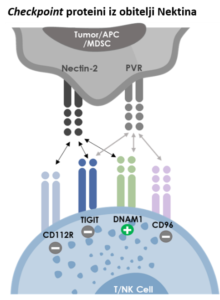
For decades, this group has been engaged in basic research on the pathogenesis of viruses and the immune response, as well as the application of this knowledge to the development of immunotherapy. Prof. Jonjić is the first Croatian scientist to win a prestigious and highly competitive European Research Council scientific project (ERC Advanced Grant) and the first winner of the so-called Proof-of-concept project. In addition, Prof. Jonjić’s research group has resulted in numerous researchers who have established their own groups in Croatia and abroad (for example, Luka Čičin-Šain at the Helmholtz Institute in Braunschweig and Prof. Pero Lučin, Prof. Bojan Polić, Prof. Astrid Krmpotić, Prof. Tihana Lenac Roviš, Associate Professor Vanda Juranić Lisnić, Assistant Professor Ilija Brizić from the Faculty of Medicine in Rijeka). Finally, Prof. Jonjić is a member of the German Academy of Sciences and Arts Leopoldina, the European Academy of Microbiology and the Academiae Europaeae. He is also the recipient of the Lifetime Achievement Award of the City of Rijeka and the Croatian Parliament’s National Science Award for Lifetime Achievement.
The focus of this research group is on developing and researching new immunotherapeutics based on monoclonal antibodies and testing their anti-tumour activity using a humanised mouse model. In cooperation with scientists from the Hebrew University in Jerusalem, with whom they founded the spin-off company Nectin Therapeutics, the group has already successfully developed several monoclonal antibodies directed at immune receptors from the nectin family. These proteins act as immune checkpoints, so targeting them overcomes inhibitory pathways and enables the antitumour activity of immune cells. The lead clone, an anti-poliovirus receptor (PVR, CD155), was recently submitted to the US Food and Drug Administration (FDA) as an investigational new drug (IND). Another antibody, directed at the inhibitory receptor TIGIT, which was also discovered by Prof. Jonjić’s group and colleagues from Israel (PNAS, 2009; EJI, 2013), is currently being investigated in preclinical studies. Numerous other antibodies are protected by patents (PCT/IL2019/050508; PCT/IL2020/050047) and are being intensively tested, partly within this research group.
Selected publications:
- Reches A, Ophir Y, Stein N, Kol I, Isaacson B, Charpak Amikam Y, Elnekave A, Tsukerman P, Kucan Brlic P, Lenac T, Seliger B, Jonjic S, Mandelboim O. Nectin4 is a novel TIGIT ligand which combines checkpoint inhibition and tumor specificity. J Immunother Cancer. 2020.
- Kučan Brlić P, Lenac Roviš T, Cinamon G, Tsukerman P, Mandelboim O, Jonjić S. Targeting PVR (CD155) and its receptors in anti-tumor therapy. Cellular and Molecular Immunology, 2018.
- Lenac Rovis T, Kucan Brlic P, Kaynan N, Juranic Lisnic V, Brizic I, Jordan S, Tomic A, Kvestak D, Babic M, Tsukerman P, Colonna M, Koszinowski U, Messerle M, Mandelboim O, Krmpotic A, Jonjic S. Inflammatory monocytes and NK cells play a crucial role in DNAM-1–dependent control of cytomegalovirus infection. Journal of experimental medicine, 2016.
- Stanietsky N, Simic H, Arapovic J, Toporik A, Levy O, Novik A, Levine Z, Beiman M, Dassa L, Achdout H, Stern-Ginossar N, Tsukerman P, Jonjic S, Mandelboim O. The interaction of TIGIT with PVR and PVRL2 inhibits human NK cell cytotoxicity. Proc Natl Acad Sci U S A. 2009.
- Stanietsky N, Rovis TL, Glasner A, Seidel E, Tsukerman P, Yamin R, Enk J, Jonjic S, Mandelboim O. Mouse TIGIT inhibits NK-cell cytotoxicity upon interaction with PVR. Eur J Immunol. 2013.
Protection of Bathing Waters
Department of Health Ecology
Research group: Protection of Bathing Waters
Assoc. Prof. Darija Vukić Lušić, PhD
Group members: Asst. Prof. Arijana Cenov, PhD (nominal title), Asst. Prof. Marin Glad, PhD (nominal title), Assoc. Prof. Dražen Lušić, PhD, Neven Sučić, M.Sc. (PhD student)
The group’s research focuses on the impact of various environmental factors on the population’s health. The group’s special interest is the improvement of bathing water quality monitoring. They compare, improve and develop methods, techniques and tools for monitoring bathing water quality. The research group is testing the application of non-routine, faster and more precise methods for monitoring the number of fecal pollution indicators in the sea (using cultivation techniques, defined substrate (DTS) and RT-PCR techniques, complemented by MALDI-TOF MS technology, which enables the identification of numerous environmental species). In cooperation with Slaven Jozić, PhD (Institute of Oceanography and Fisheries, Split) and other colleagues from coastal counties’ institutes of public health, the group participated in the modification of the ISO method for detecting E. coli in seawater. The method has been approved by the European Commission and can be used to detect E. coli in bathing waters (sea and land waters) in the Republic of Croatia. In cooperation with colleagues from the Faculty of Engineering in Rijeka, for the first time in Croatia and in the region, they have developed and applied a bathing water quality prediction model based on historical data on sea quality and weather forecasts. The group is participating in several scientific projects: 2021–2024 EUROBATH – Towards the New European Union Bathing Water Directive – project funded by the Croatian Science Foundation; 2020–2023 KLIMOD – Computational Models of Flow, Flooding and Pollution Dispersion in Rivers and Coastal Seawaters – project funded by the EU; 2020–2023 ProtectAs – Development of System for Control and Protection of Ports from Introduction of Alien Species – project funded by the EU; 2018–2023 Adjustment to the New EU Directive on Bathing Water Quality – project funded by UNIRI; 2018–2023 Karst Modeling with Public Health and Socio-Economic Implications – project funded by UNIRI+. The results of the aforementioned research influence the making of new regulations in this field.
Selected publications:
- Mance, Diana; Mance, Davor; Vukić Lušić, Darija. Environmental and anthropogenic factors affecting coastal bathing water quality: preliminary study for Primorje-Gorski Kotar County (Croatia) // Pomorstvo: Scientific Journal Of Maritime Research, 35 (2021), 1; 57-68. doi: 10.31217/p.35.1.7
- Jozić, Slaven; Baljak, Vanja; Cenov, Arijana; Lušić, Dražen; Galić, Dominik; Glad, Marin; Maestro, Daniel; Maestro, Nerma; Kapetanović, Damir; Kraus, Romina; Marinac-Pupavac, Sandra; Vukić Lušić, Darija. Inland and coastal bathing water quality in the last decade (2011–2020): Croatia vs. region vs. EU // Water, 13 (2021), 17; 2440, 15. doi: 10.3390/w13172440
- Topić, Nancy; Cenov, Arijana; Jozić, Slaven; Glad, Marin; Mance, Diana; Lušić, Dražen; Kapetanović, Damir; Mance, Davor; Vukić Lušić, Darija. Staphylococcus aureus – An Additional Parameter of Bathing Water Quality for Crowded Urban Beaches // International Journal of Environmental Research and Public Health, 18 (2021), 10; 5234, 13. doi: 10.3390/ijerph18105234
- Glažar Ivče, Daniela; Rončević, Dobrica; Šantić, Marina; Cenov, Arijana; Tomić Linšak, Dijana; Mićović, Vladimir; Lušić, Dražen; Glad, Marin; Ljubas, Davor; Vukić Lušić, Darija. Is a Proactive Approach to Controlling Legionella in the Environment Justified? // Food Technology and Biotechnology, 59 (2021), 3; 314-324. doi: 10.17113/ftb.59.03.21.7016
- Jozić, Slaven; Baljak, Vanja; Cenov, Arijana; Lušić, Dražen; Galić, Dominik; Glad, Marin; Maestro, Daniel; Maestro, Nerma; Kapetanović, Damir; Kraus, Romina; Marinac-Pupavac, Sandra; Vukić Lušić, Darija. Quality of Croatian Inland Bathing Areas: Reference to the Region and EU // Journal of Health Sciences, 11 (2021), 1; 37-46. doi: 10.17532/jhsci.2021.1110
Bathing water quality prediction model

Physics in Medicine
Department of Medical Physics and Radiation Protection, Clinical Hospital Centre Rijeka
Department of Medical Physics and Biophysics, Faculty of Medicine, University of Rijeka
Research group: Physics in Medicine
Assoc. Prof. Slaven Jurković, PhD
This research group consists of ten physicists from the Department of Medical Physics and Radiation Protection of the Clinical Hospital Centre Rijeka, four of whom are doctors of science and five of whom are currently conducting their doctoral research. The group focuses on research on the physical aspects of the application of ionizing radiation, nuclear magnetic resonance and artificial intelligence in medicine. Many of the group’s activities are focused on designing and conducting research related to the projects of the International Atomic Energy Agency (IAEA). In the last five years, this has resulted in the publication of more than twenty scientific papers and more than thirty conference papers.
International scientific collaborations include those with the Oncology Institute, Ljubljana, Slovenia; Lund University, Sweden, Azienda Ospedaliero Universitaria Maggiore della Carità, Novara, Italy; and Massachusetts General Hospital, Boston, USA.
In 2020, the Department received the Annual Award of the City of Rijeka for the international recognition of excellence in the application of physics in medicine at the Rijeka Clinical Hospital Centre.
Selected publications:
- Pribanić, Ivan; Simić, Srđan Daniel; Tanković, Nikola; Dundara Debeljuh, Dea; Jurković, Slaven. Reduction of SPECT acquisition time using deep learning: A phantom study, European Journal of Medical Physics, 111 (2023) https://doi.org/10.1016/j.ejmp.2023.102615
- Šegedin, Nikola; Hršak, Hrvoje; Dolanski Babić, Sanja; Jurković, Slaven. Determination of volume averaging correction factors using an elliptical absorbed dose model for Gamma Knife Perfexion, Journal of Applied Clinical Medical Physics; 24 (2023), https://doi.org/10.1002/acm2.14109
- Božanić, Ana; Šegota, Doris; Dundara Debeljuh, Dea; Švabić Kolacio, Manda; Smilović Radojčić, Đeni; Ružić, Katarina; Budanec, Mirjana; Kasabašić, Mladen; Hrepić, Darijo; Valković Zujić, Petra; Brambilla, Marco; Kalra, Mannudeep; Jurković, Slaven. National Reference Levels of CT Procedures dedicated for Treatment Planning in Radiation Oncology, European Journal of Medical Physics, 96 (2022) 123–129, https://doi.org/10.1016/j.ejmp.2022.03.001
- Švabić Kolacio, Manda; Brkić, Hrvoje; Faj, Dario; Smilović Radojčić, Đeni; Rajlić, David; Obajdin; Nevena; Jurković, Slaven. Validation of two calculation options built in Elekta Monaco Monte Carlo based algorithm using MCNP code. Radiation physics and chemistry, 179 (2021), https://doi.org/10.1016/j.radphyschem.2020.109237
- Smilović Radojčić, Đeni; Casar, Božidar; Rajlić, David; Švabic Kolacio, Manda; Mendez, Ignasi; Obajdin, Nevena; Dundara Debeljuh, Dea; Jurković, Slaven. Experimental validation of Monte Carlo based treatment planning system in bone density equivalent media. Radiology and oncology, 54 (2020), 4; 495-504 https://doi.org/10.2478/raon-2020-0051
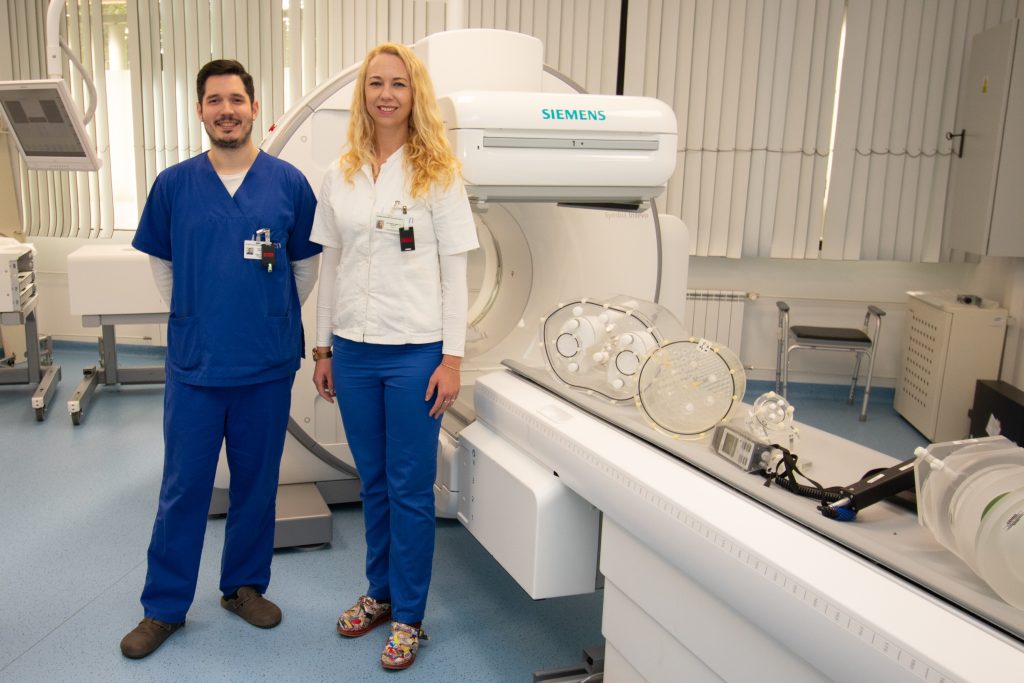
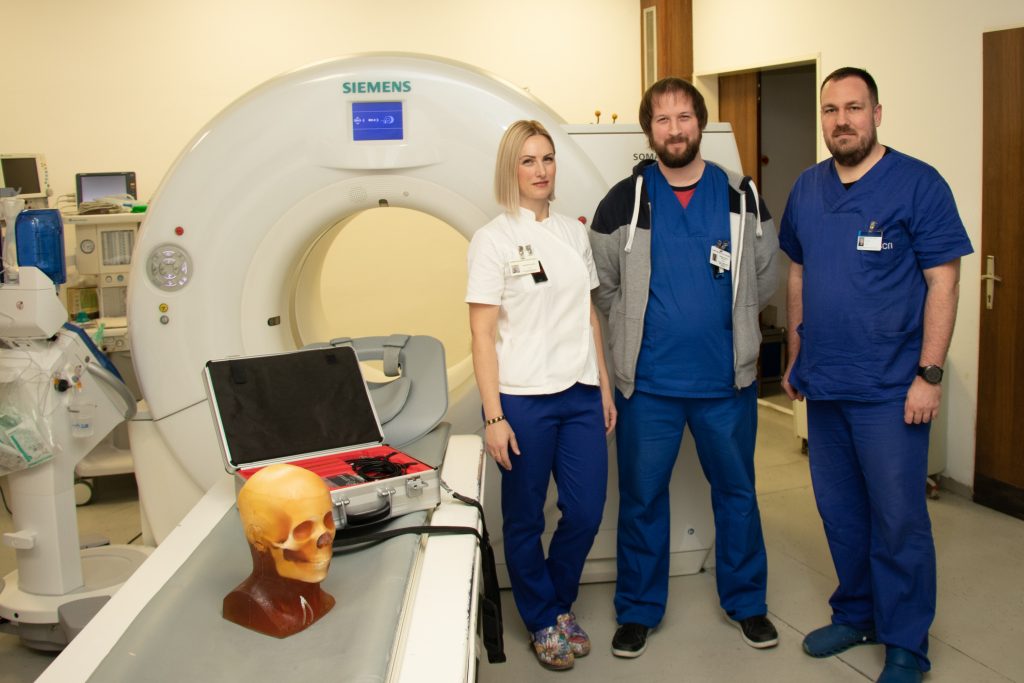
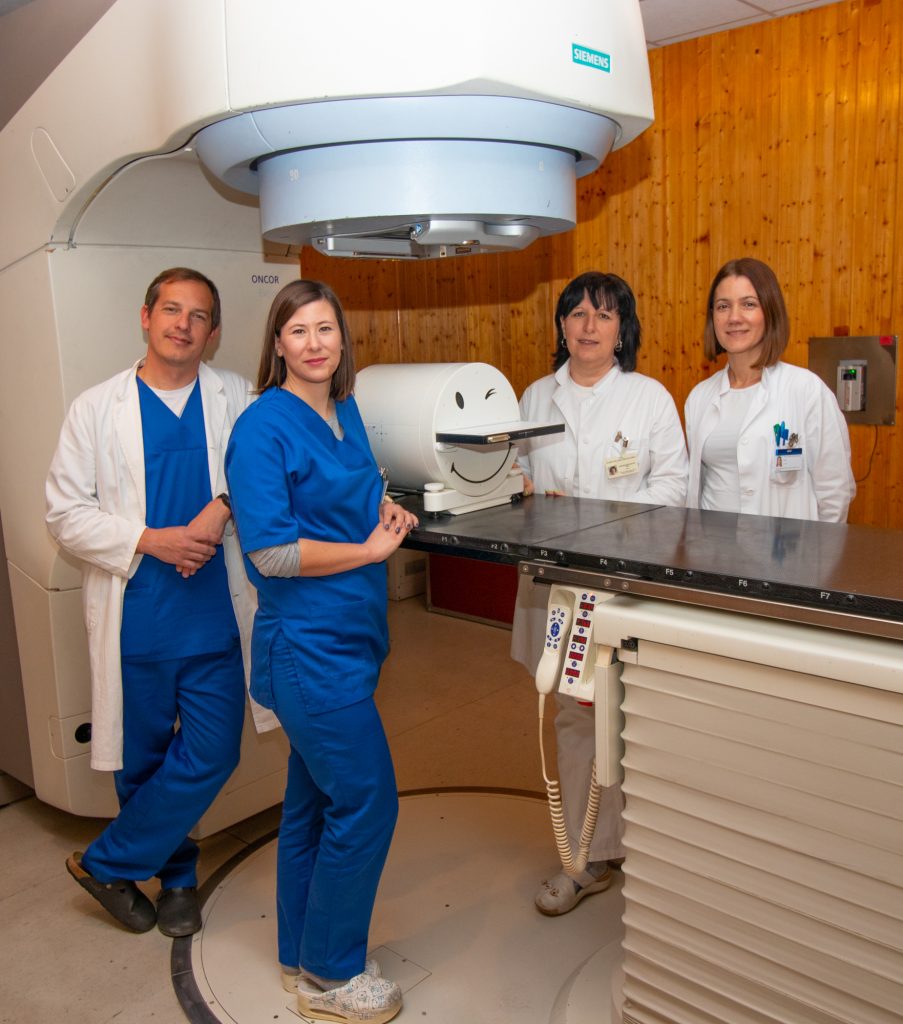
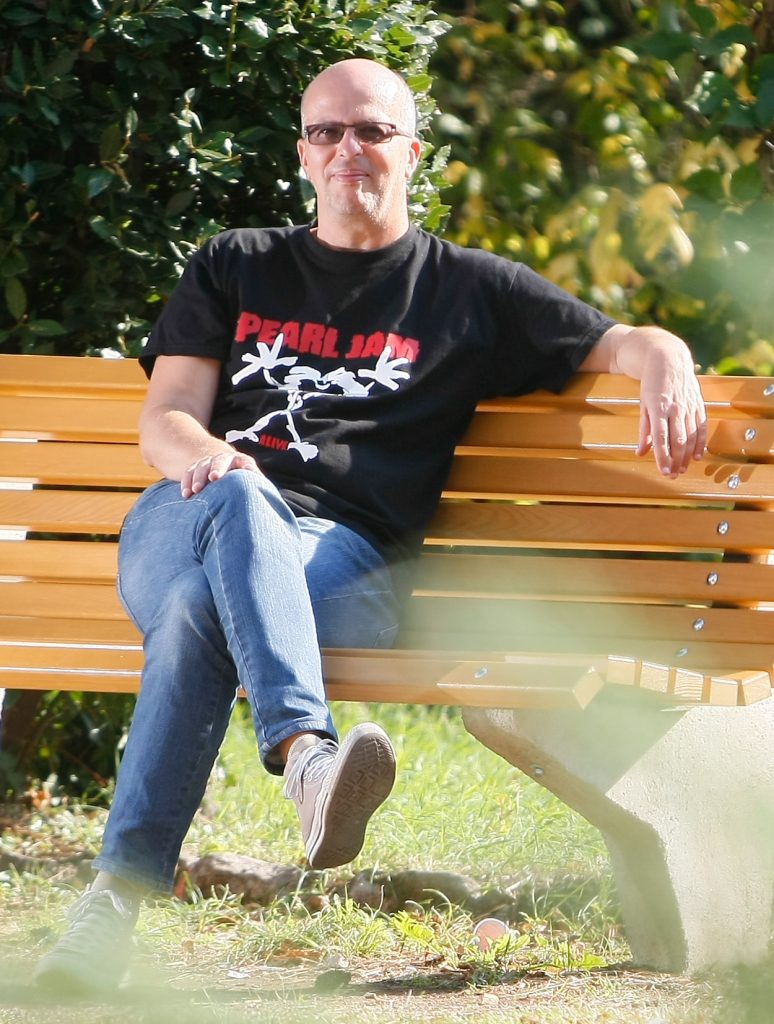
Extracellular Vesicles
Research group: Extracellular Vesicles
Group members: Assoc. Prof. Kristina Grabušić, PhD, Vedrana Krušić Alić, M.Sc. (PhD student), Lara Valenčić Seršić, MD, Assist. Prof. Janja Tarčuković, MD, DESAIC, PhD, Siniša Zrna, MD, Maša Biberić, MD, Tin Jagoić (sixth-year student), Anton Bilić (fifth-year student)
Research description
Our group is investigating human extracellular vesicles (EVs) to discover diagnostic and prognostic biomarkers. EVs are tiny particles that cells secrete into the extracellular space (Figure 1). They are enclosed by a lipid bilayer similar to the cell membrane, and in addition to membrane lipids and proteins, they can contain different molecules in their hydrophilic interior, such as proteins, nucleic acids and metabolites. Which molecules will make up the EV content depends on the type of cell and its current (patho)physiological status. Therefore, the molecular composition of EVs is dynamic and can be used as a source of biomarkers, since EVs reflect the type and condition of the tissue from which they originate.
An additional characteristic of EVs useful for their biomarker potential is that EVs are secreted into body fluids. The aforementioned properties of EVs form the basis for liquid biopsy, which could be applicable for monitoring the condition even of internal organs, which are difficult to access or may not be accessible at all.
Our current focus is to investigate EVs from the cerebrospinal fluid of patients with traumatic brain injury. Traumatic brain injury is caused by physical damage to the brain tissue and leads to further series of pathological changes in the nervous tissue. Our results indicate that EVs could carry proteins and miRNAs necessary for the early initiation of processes for brain tissue recovery.
Graphical abstract
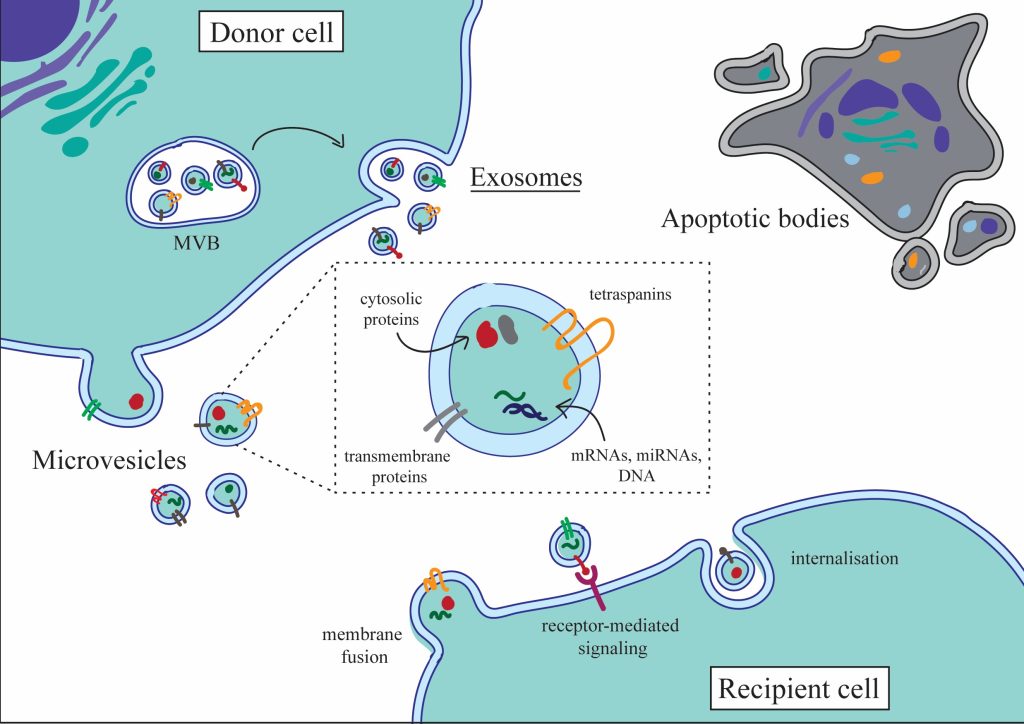
Figure 1. Microvesicles, exosomes and apoptotic bodies are just some of the extracellular vesicle (EV) types that various cells secrete into the extracellular space. The molecular content of EVs can be very diverse. In addition to lipids and proteins, it might also include nucleic acids and metabolites. EVs can interact with the recipient cell in different ways and change its behaviour.
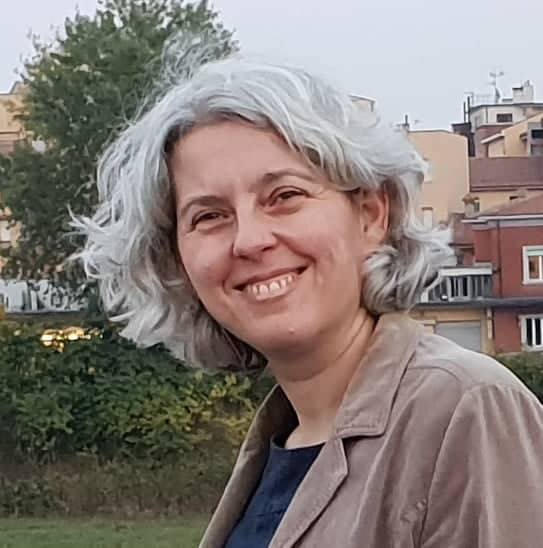
Assoc. Prof. Kristina Grabušić
Department of Physiology, Immunology and Pathophysiology
Faculty of Medicine in Rijeka, Croatia
kristina.grabusic@uniri.hr
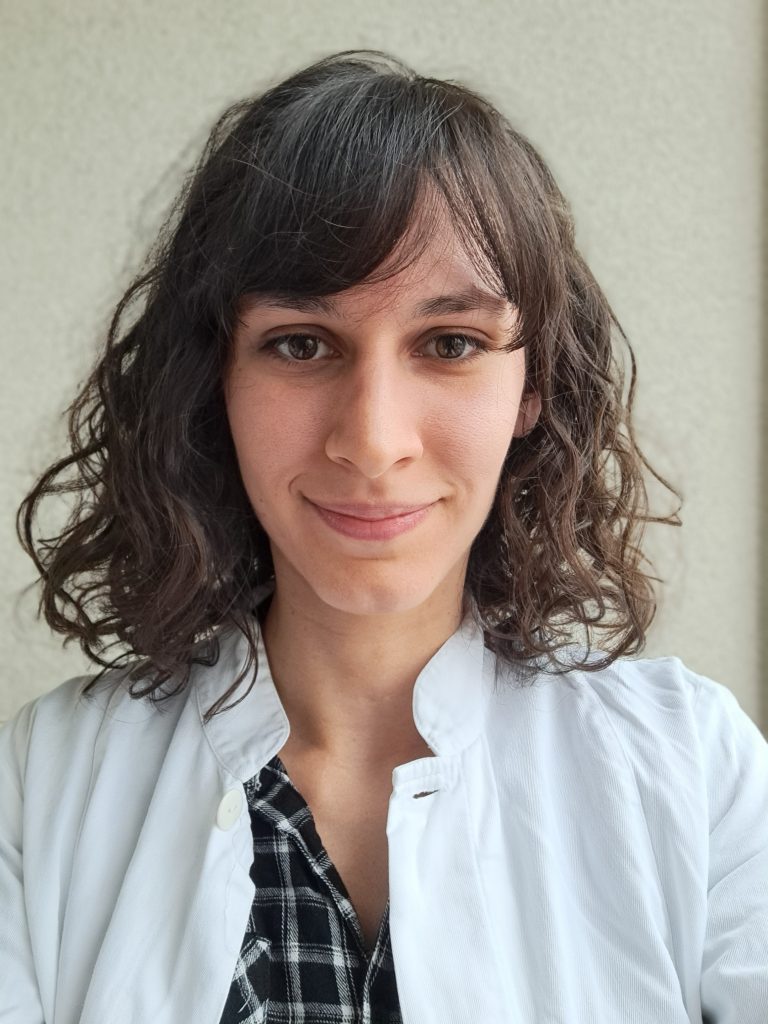
Vedrana Krušić Alić, mag. biotech. in med.
PhD student
Dpt. for Physiology, Immunology and Pathophysiology
Faculty of Medicine in Rijeka, Croatia
vedrana.krusic@uniri.hr
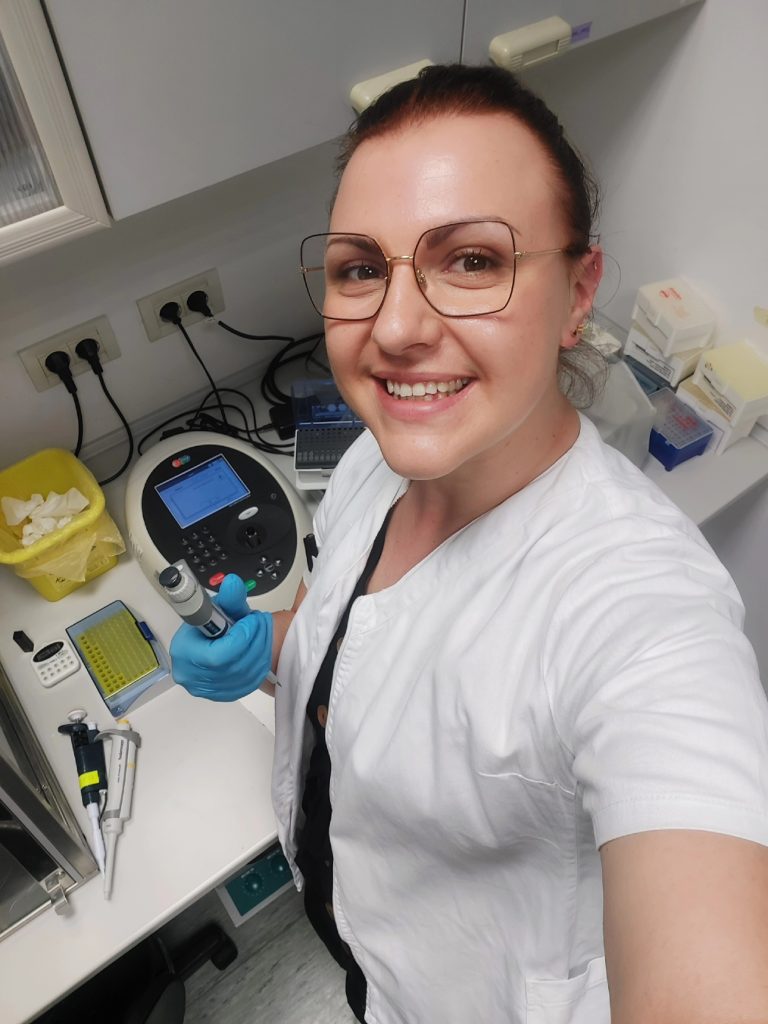
Lara Valenčić Seršić, MD
PhD student
Resident in anaesthesiology, resuscitation and intensive care
Dpt. of Anaesthesiology, Resuscitation, Emergency and Intensive Care Medicine
Faculty of Medicine in Rijeka, Croatia
lara.valencic@uniri.hr
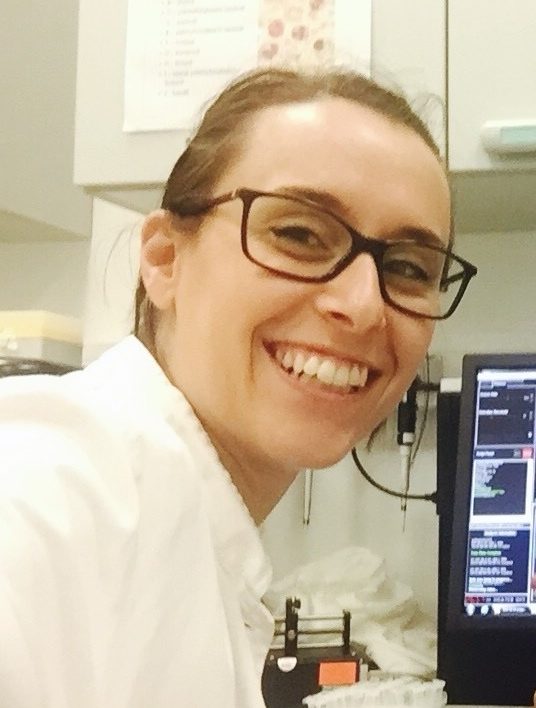
Assist. Prof. Janja Tarčuković, MD DESAIC
Specialist in anaesthesiology, resuscitation and intensive care
Subspecialist in intensive care medicine
Dpt. of Anaesthesiology, Resuscitation, Emergency and Intensive Care Medicine
Faculty of Medicine in Rijeka, Croatia
janja.kuharic@uniri.hr
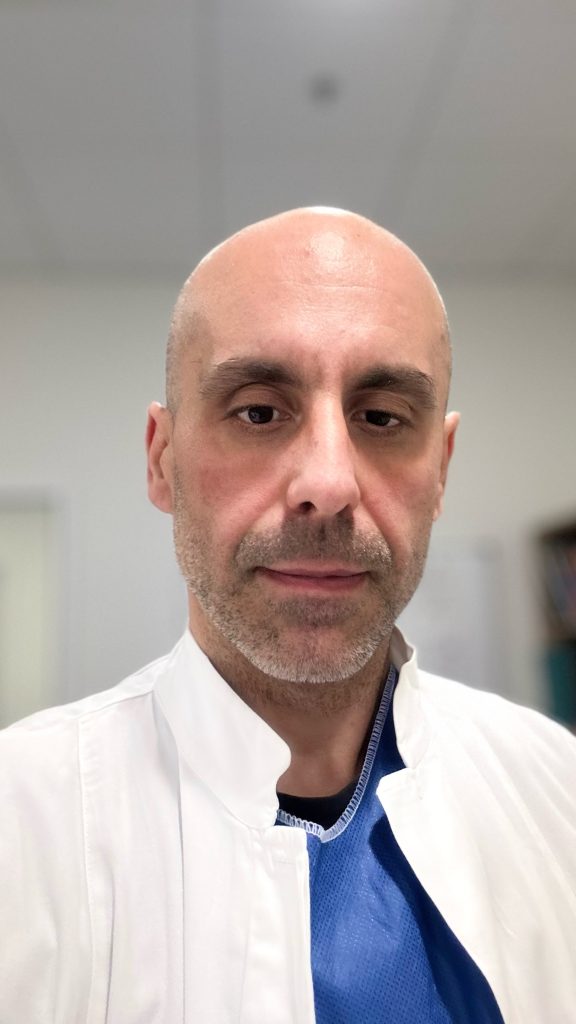
univ.mag.med. Siniša Zrna, MD
Specialist in anaesthesiology, resuscitation and intensive care
Subspecialist in intensive care medicine
Dpt. of Anaesthesiology, Resuscitation, Intensive Care Medicine and Pain Management
Pula General Hospital, Croatia
sinisa.zrna@obpula.hr
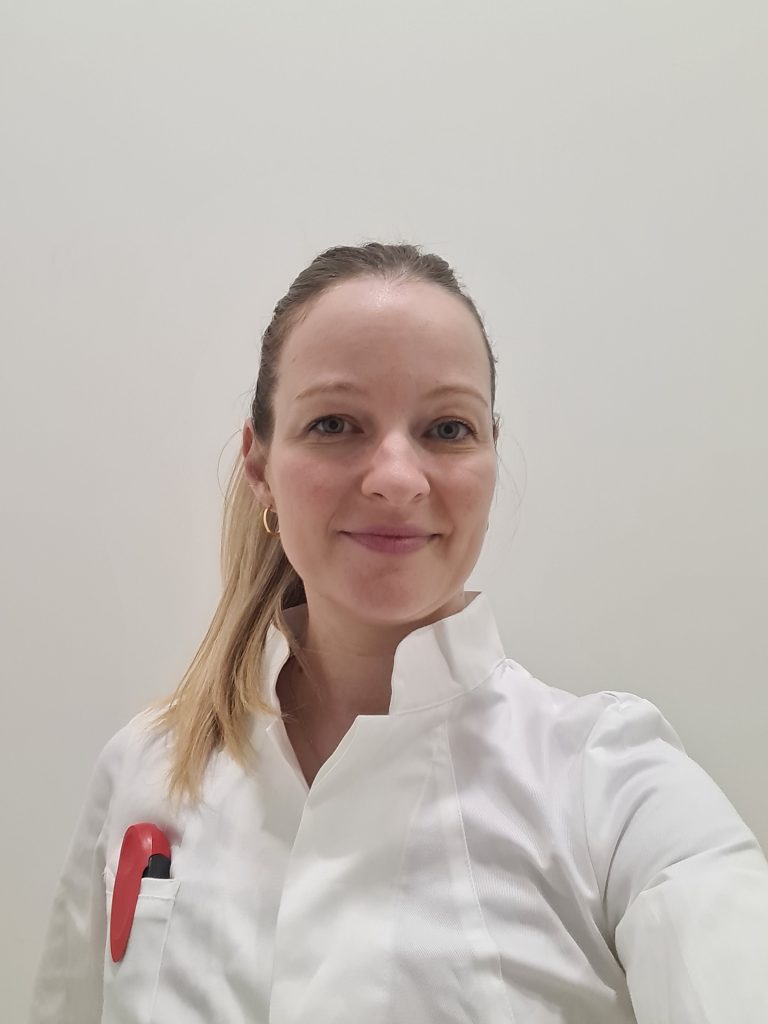
univ.mag.med. Maša Biberić, dr. med.
Specialist in anaesthesiology, resuscitation and intensive care
Subspecialist in intensive care medicine
Dpt. of Anaesthesiology, Resuscitation, Intensive Care Medicine and Pain Management
Pula General Hospital, Croatia
masa.biberic@obpula.hr
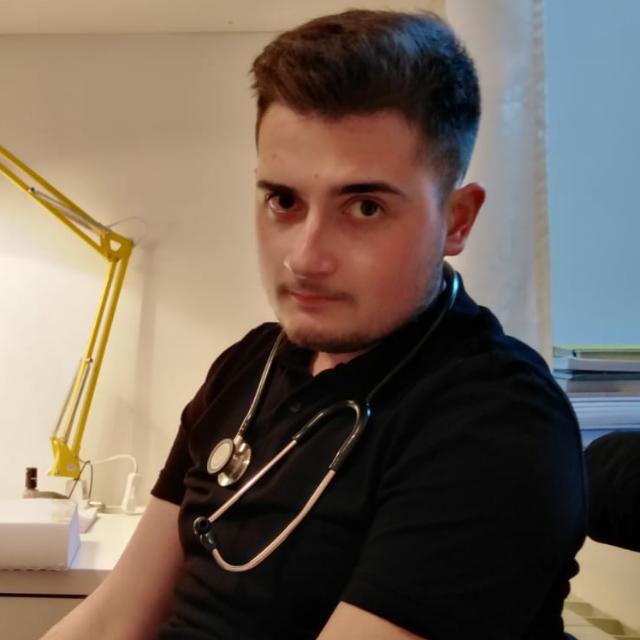
Tin Jagoić
Student of Medicine, 6th year
Faculty of Medicine in Rijeka, Croatia
tjagoic@student.uniri.hr
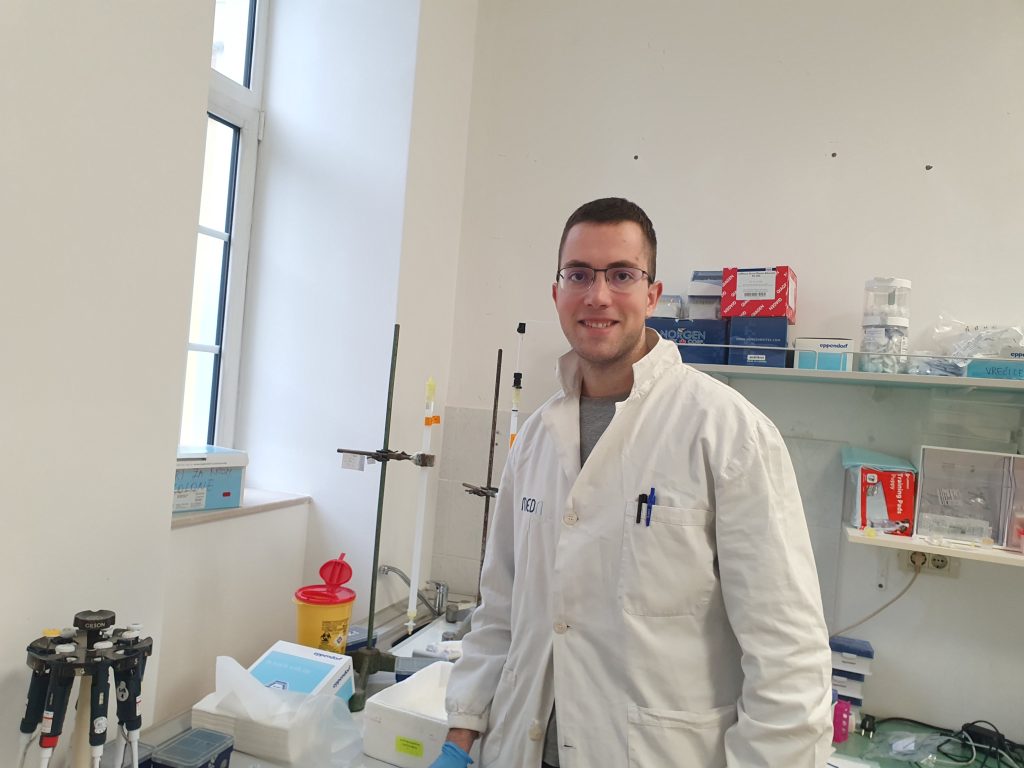
Anton Bilić
Student of Medicine, 5th year
Faculty of Medicine in Rijeka, Croatia
abilic1@student.uniri.hr
Selected publications:
- Lara Valenčić Seršić, Vedrana Krušić Alić, Maša Biberić, Siniša Zrna, Tin Jagoić, Janja Tarčuković, and Kristina Grabušić, Real-Time PCR Quantification of 87 miRNAs from Cerebrospinal Fluid: miRNA Dynamics and Association with Extracellular Vesicles after Severe Traumatic Brain Injury, Int. J. Mol. Sci. 2023, 24(5), 4751; https://doi.org/10.3390/ijms24054751
- Mario Kurtjak, Sami Kereïche, Damir Klepac, Hrvoje Križan, Marko Perčić, Vedrana Krušić Alić, Teja Lavrin, Metka Lenassi, Karmen Wechtersbach, Nika Kojc, Marija Vukomanović, Siniša Zrna, Maša Biberić, Robert Domitrović, Kristina Grabušić, and Mladenka Malenica, Unveiling the Native Morphology of Extracellular Vesicles from Human Cerebrospinal Fluid by Atomic Force and Cryogenic Electron Microscopy, MDPI Biomedicines 2022, 10, 1251. https://doi.org/10.3390/biomedicines10061251
- Vedrana Krušić Alić, Mladenka Malenica, Maša Biberić, Siniša Zrna, Lara Valenčić, Aleksandar Šuput, Lada Kalagac Fabris, Karmen Wechtersbach, Nika Kojc, Mario Kurtjak, Natalia Kučić and Kristina Grabušić, Extracellular Vesicles from Human Cerebrospinal Fluid Are Effectively Separated by Sepharose CL-6B—Comparison of Four Gravity-Flow Size Exclusion Chromatography Methods, Biomedicines. 2022 Mar 27;10(4):785. doi: 10.3390/biomedicines10040785.
- Mladenka Malenica, Marija Vukomanović, Mario Kurtjak, Valentina Masciotti, Simone dal Zilio, Silvio Greco, Marco Lazzarino, Vedrana Krušić, Marko Perčić, Ivana Jelovica Badovinac, Karmen Wechtersbach, Ivona Vidović, Vanja Baričević, Srećko Valić, Pero Lučin, Nika Kojc and Kristina Grabušić, Perspectives of Microscopy Methods for Morphology Characterisation of Extracellular Vesicles from Human Biofluids, Biomedicines. 2021 May 26;9(6):603. doi: 10.3390/biomedicines9060603.
- Kuharić J, Grabusic K, Sotosek Tokmadzic V, Štifter S, Tulić K, Shevchuk O, Lučin P, Šustić A. Severe traumatic brain injury induces early changes in the physical properties and protein composition of intracranial extracellular vesicles. J Neurotrauma. 2019 Jan 15;36(2):190-200. doi: 10.1089/neu.2017.5515. Epub 2018 Aug 10
Pathophysiology and Pharmacotherapy of Brain Trauma and Cerebral Ischemia
Department of Basic and Clinical Pharmacology and Toxicology
Research group: Pathophysiology and Pharmacotherapy of Brain Trauma and Cerebral Ischemia
Prof. Kristina Pilipović, MD, PhD
Group members: Prof. Jasenka Mršić-Pelčić, MD, PhD, Prof. Jasna Križ, MD, PhD, Asst. Prof. Petra Dolenec, M.Sc., PhD, Asst. Prof. Anja Harej Hrkać, M.Sc., PhD, Tamara Janković, M.Sc.EPH, PhD, Jelena Rajič Bumber, M.Sc., PhD, Nika Gržeta, M.Sc., Iva Kristić, M.Sc.
The research team led by Prof. Kristina Pilipović, MD, PhD focuses on discovering the pathological and pathophysiological foundations of various conditions associated with damage to the central nervous system. Research also covers the study and evaluation of potential pharmacotherapy interventions for the mentioned conditions. Originally formed as part of the research project funded by the Croatian Science Foundation, Single-Walled Carbon Nanotubes in Experimental Traumatic Brain Injury (CarNanoTBI), the team’s scope of work has been expanded. In addition to research on traumatic brain injury, the group also studies the pathophysiological foundation of the development of neurodegenerative disorders resulting from cerebral ischemia and epilepsy. The team also investigates the impact of chronic diseases outside the central nervous system, such as diabetes, on structural and functional changes in the brain. Furthermore, the group also explores potential pharmacotherapeutic strategies for the treatment of the mentioned diseases. The team wants to investigate new indications for established drugs and evaluate the pharmacological potential of natural (plant-derived) compounds that are insufficiently investigated in these pathological conditions.
Selected publications:
- Gržeta Krpan N, Harej Hrkać A, Janković T, et al. Chemically Functionalized Single-Walled Carbon Nanotubes Prevent the Reduction in Plasmalemmal Glutamate Transporter EAAT1 Expression in, and Increase the Release of Selected Cytokines from, Stretch-Injured Astrocytes in Vitro. Cells. 2024;13(3):225.
- Pilipović K, Jurišić Grubešić R, Dolenec P, Kučić N, Juretić L, Mršić-Pelčić J. Plant-Based Antioxidants for Prevention and Treatment of Neurodegenerative Diseases: Phytotherapeutic Potential of Laurus nobilis, Aronia melanocarpa, and Celastrol. Antioxidants (Basel). 2023;12(3):746.
- Janković T, Dolenec P, Rajič Bumber J, et al. Differential Expression Patterns of TDP-43 in Single Moderate versus Repetitive Mild Traumatic Brain Injury in Mice. Int J Mol Sci. 2021;22(22):12211.
- Rajič Bumber J, Pilipović K, Janković T, et al. Repetitive Traumatic Brain Injury Is Associated With TDP-43 Alterations, Neurodegeneration, and Glial Activation in Mice. J Neuropathol Exp Neurol. 2021;80(1):2-14.
- Mršić-Pelčić J, Pilipović K, Pelčić G, Vitezić D, Župan G. Decrease in Oxidative Stress Parameters after Post-Ischaemic Recombinant Human Erythropoietin Administration in the Hippocampus of Rats Exposed to Focal Cerebral Ischaemia. Basic Clin Pharmacol Toxicol. 2017;121(6):453-464.

Validation of Contrast-Enhanced Mammography as a Method of Breast Imaging in Comparison with Standard Mammography and Tomosynthesis
Coordinator: Assoc. Prof. Petra Valković Zujić, MD, PhD (Department of Radiology)
Associates: Assoc. Prof. Slaven Jurković, PhD and Doris Šegota Ritoša, M.Ed. (Department of Medical Physics and Biophysics), Asst. Prof. Manuela Avirović, MD, PhD (Department of General Pathology and Pathological Anatomy), Asst. Prof. Jana Katunar, M.Ed., PhD (Department of Business Economics, Faculty of Economics in Rijeka), Nina Bartolović, MD and Mateo Madunić, MD (Department of Radiology) and Ana Car Peterko, MD (Department of Surgery). Associates outside the University constituents are radiologists from the Community Health Centre of the Primorje-Gorski Kotar County, Emina Grgurević Dujmić, MD and Sabina Lenac, MD.
The goal of the project is to detect the problems and shortcomings of the current breast imaging methods thanks to the cooperation of the academic community, the Community Health Centre of the Primorje-Gorski Kotar County and business partners, and to propose contrast-enhanced mammography as a method that would speed up examination and increase efficiency by determining the cost ratio compared with other imaging methods. Furthermore, the goal of the project is to establish long-term cooperation between research centres, stakeholders and the economy with the dissemination of knowledge. The results of the research may confirm the hypothesis and improve breast cancer diagnosis under cost-effective conditions.
The activities planned for this project include the following:
With the help of partners from the public health system, the possibility of implementing contrast-enhanced mammography as a method of choice will be assessed for a defined group of respondents.
Based on the previously collected data, the financial impact of the CEM method will be analysed with colleagues from the Faculty of Economics in Rijeka in terms of cost efficiency for the public health system compared with the socioeconomic and financial impacts on the patient’s lifestyle and work.
After confirming the hypothesis that the method researched is highly effective, and after detecting tumours in the target group at an early stage without deviations in the effectiveness of the CEM method compared with MR imaging, the clinical and socioeconomic advantages and disadvantages of introducing and applying the CEM method in clinical practice will be elaborated (cost-benefit analysis).
The project collaboration of scientists from several University of Rijeka constituents contributes to mutual cohesion and a better understanding of early breast cancer diagnosis, while interdisciplinary research additionally connects stakeholders from different scientific research areas as well as stakeholders from science and industry.
Selected publications: the group has successfully submitted the research protocol as part of the project to the ClinicalTrials.gov platform ID NCT06217458.
